Today was huge! First the Historiska Museet, followed by a jaunt around the Gamla Stan, then an Archipelago Tour and then the Thredbo Conference dinner at the Vasa Museet. I took so many photos in these places that I have decided to split it up into three posts or I will have to skip over things that I’d like to be able to store and remember.
I started off the day at the Historiska Museet to discover some beautiful Viking age and Medieval artefacts. The collection is seriously impressive – and I took so many photos (over 250) that I had to create an entirely separate post of these items for my medieval re-enactor friends. So many artefacts with so much information! A lot of the Iron Age information was accessible (ie: in English), because Vikings are so popular these days – but unfortunately a lot of the pre-Viking era artefacts were in galleries that only had information in Swedish. I will do my best to include as much of the English information that I was able to glean on the items in the more comprehensive post, but for here I have inserted just a small selection of cool pics.

The museum itself was founded in 1866 and is a government run agency that covers Swedish archaeology and cultural history from the Mesolithic period to the modern era – thankfully not a lot of that modern era bit. The collections were started based on objects collected by various Swedish monarchs from the late 1800s and have grown from there.
Wealthy farmers and aristocrats alike, had rune stones and petroglyphs (picture stones) made, usually to commemorate dead relatives. They were made by specialist stone cutters and were painted in strong colours. Most of the rune stones at this museum have come from Gotland.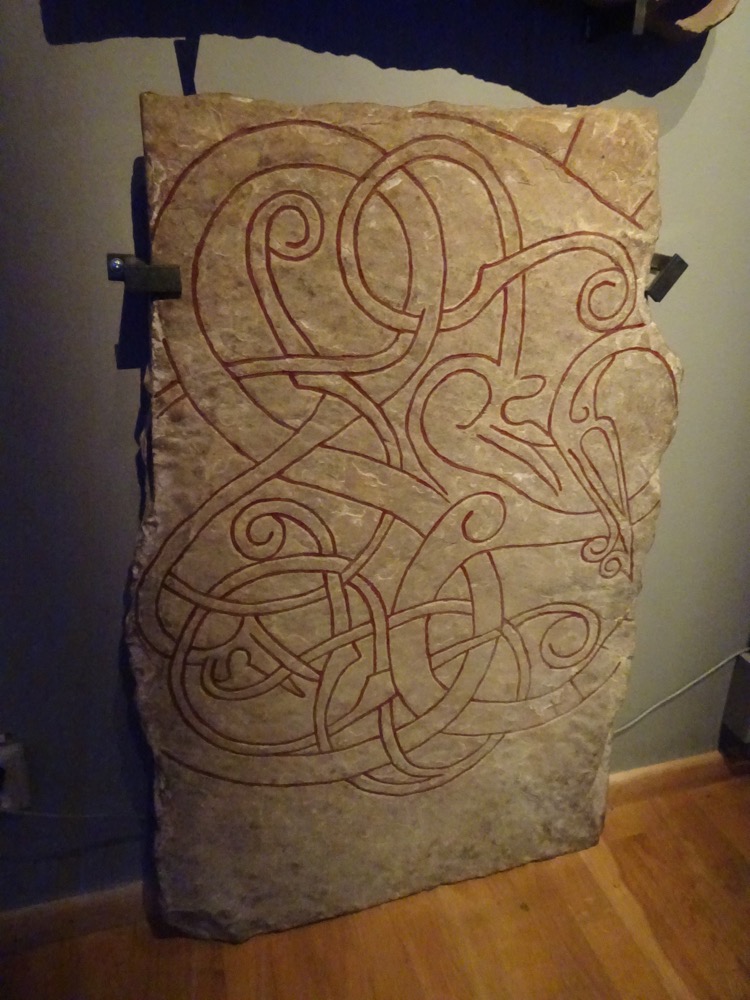 Brooches and pendants galore!
Brooches and pendants galore!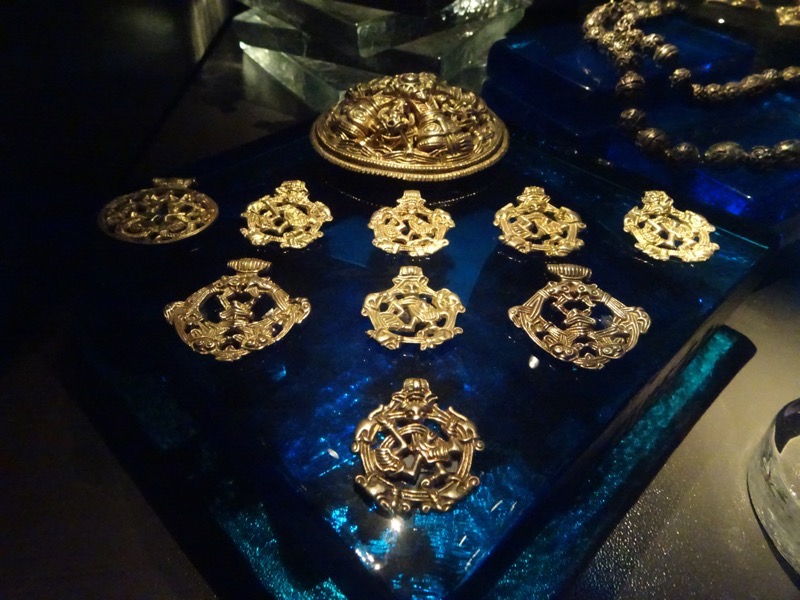 Viking era swords with magnificent pommels (more detailed pictures will be included in the other post).
Viking era swords with magnificent pommels (more detailed pictures will be included in the other post). Grave finds from a Birka Princess – brooches, and beads, coat clasp.
Grave finds from a Birka Princess – brooches, and beads, coat clasp.
 The Gold Room – a chamber under the museum that houses over 3000 gold and silver artefacts.
The Gold Room – a chamber under the museum that houses over 3000 gold and silver artefacts.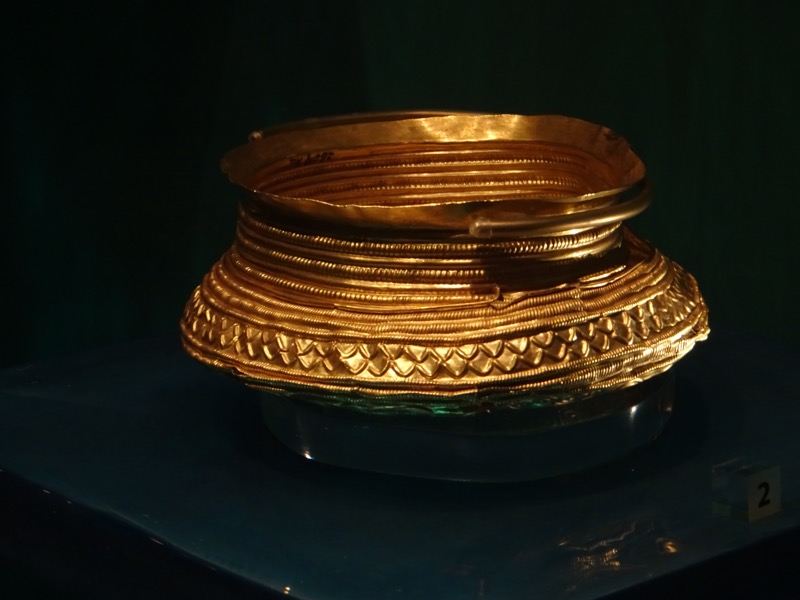

 In the courtyard during the summer, re-enactors set up tents, cook, do blacksmithing, weave, and display the Viking lifestyle.
In the courtyard during the summer, re-enactors set up tents, cook, do blacksmithing, weave, and display the Viking lifestyle.


After the Historiska Museet, I was meeting Mr K at the Gamla Stan for a bit of a walking tour. We ended up doing our own walking tour of the area and wound through the cobbled medieval streets marvelling at the old buildings, as they have been repurposed to be tourist central – lots of cafes, restaurants and souvenir shops selling all things Swedish… well, at the very least, a lot of things made in China that have ‘Sweden’ written all over them! 😉
 St George slaying the Dragon statue is a popular trope
St George slaying the Dragon statue is a popular trope
 Gamla stan is the old town of Stockholm it consists primarily of the island of Stadsholmen. This area of the town dates back to the 13thC and is largely winding medieval alleyways, rough cobbled streets (that I have no idea how ladies in high heels navigate safely), and archaic architecture. The North German style of architecture is very prevalent here and is evident in all the Gamla stan’s construction. With the exception of the square I imagine, that many of these streets rarely see sunlight in winter.
Gamla stan is the old town of Stockholm it consists primarily of the island of Stadsholmen. This area of the town dates back to the 13thC and is largely winding medieval alleyways, rough cobbled streets (that I have no idea how ladies in high heels navigate safely), and archaic architecture. The North German style of architecture is very prevalent here and is evident in all the Gamla stan’s construction. With the exception of the square I imagine, that many of these streets rarely see sunlight in winter.
 This space is the Stortorget which is the large public square in the centre of Gamla Stan. Surrounding it are rows of old merchants’ houses, including the Stockholm Stock Exchange Building (which now houses the Nobel Museum that I went to the other day). The square was the site of the Stockholm Bloodbath in Nov 1520, where Swedish aristocrats and nobility were massacred by the Danish King, Christian II. The subsequent revolt and civil war led to the dissolution of the Kalmar Union and soon followed the election of King Gustav I – well worth reading up on if you are interested in medieval history.
This space is the Stortorget which is the large public square in the centre of Gamla Stan. Surrounding it are rows of old merchants’ houses, including the Stockholm Stock Exchange Building (which now houses the Nobel Museum that I went to the other day). The square was the site of the Stockholm Bloodbath in Nov 1520, where Swedish aristocrats and nobility were massacred by the Danish King, Christian II. The subsequent revolt and civil war led to the dissolution of the Kalmar Union and soon followed the election of King Gustav I – well worth reading up on if you are interested in medieval history.
 Love the picturesque cobbled streets. Below… ‘authentic’ Swedish souvenirs. 😉
Love the picturesque cobbled streets. Below… ‘authentic’ Swedish souvenirs. 😉 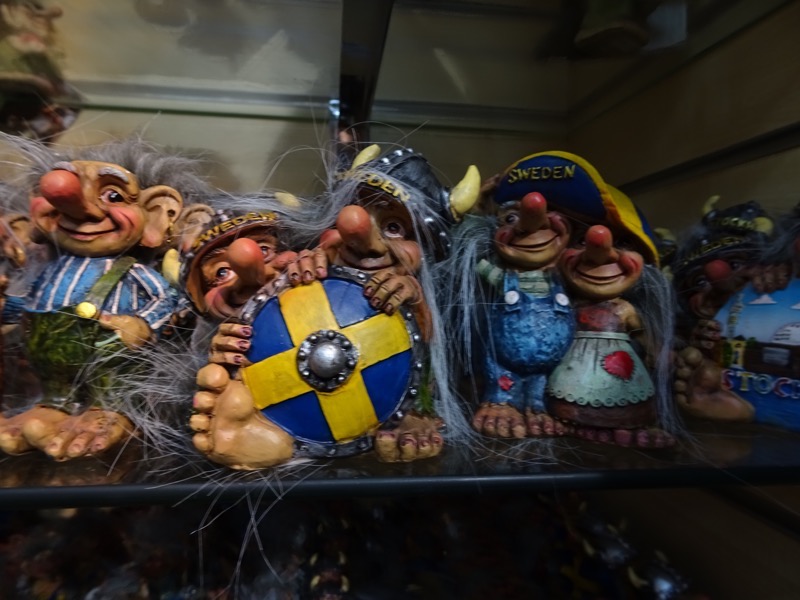

 This is a little cafe down a quiet side street, where we stopped for a quick bite to eat.
This is a little cafe down a quiet side street, where we stopped for a quick bite to eat. On our way out of the Gamla Stan, we stumbled over a boiled sweets store. I always love watching the sugar workers make these. The shop has an aroma that entices you in from half way up the street, and contains wall to wall candy to take home.
On our way out of the Gamla Stan, we stumbled over a boiled sweets store. I always love watching the sugar workers make these. The shop has an aroma that entices you in from half way up the street, and contains wall to wall candy to take home.


After we left the Gamla stan we had to hightail it by the subway to the Nybrogaten harbour to re-join the conference delegates to do a tour of the Stockholm Archipelago. As soon as we alighted the canal boat, we were welcomed to the Baltic Sea. Which very probably means very little, but sounded very cool to someone who lives closest to the Coral and Tasman Seas. 🙂 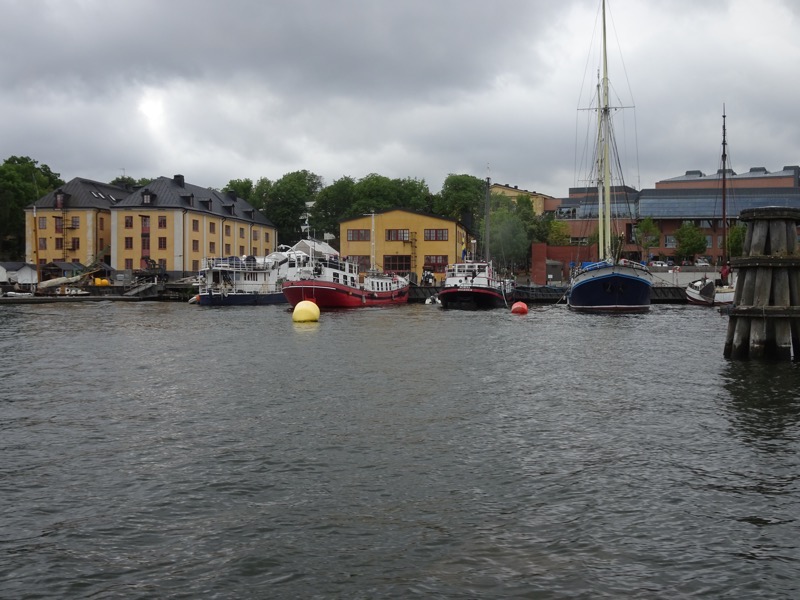 This fortification marked the old entrance to the city of Stockholm, the flag that flies over the tower is raised in times of peace and has been raised every day for the last 203 years.
This fortification marked the old entrance to the city of Stockholm, the flag that flies over the tower is raised in times of peace and has been raised every day for the last 203 years. 
Formerly called the ‘Dunboyne’ (1888–1915) and then, the ‘G.D Kennedy’ (1915-23), but now the ‘af Chapman’, is a full-rigged steel ship that moored on the shore of the small island of Skeppsholmen in central Stockholm. It was a military ship, a training ship, a barracks ship – and now it serves as a floating youth hostel.  The oldest Clock Tower in the Gamla Stan beside the Royal Palace as seen from the canal.
The oldest Clock Tower in the Gamla Stan beside the Royal Palace as seen from the canal.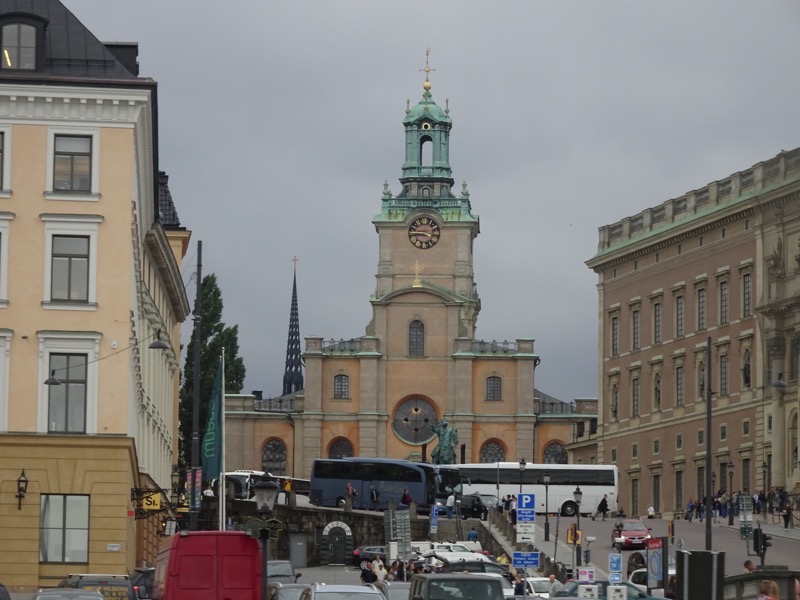 Wealthy merchants and nobles fought for land to build their homes along the canal front as premiere real estate as early as the 1500s.
Wealthy merchants and nobles fought for land to build their homes along the canal front as premiere real estate as early as the 1500s.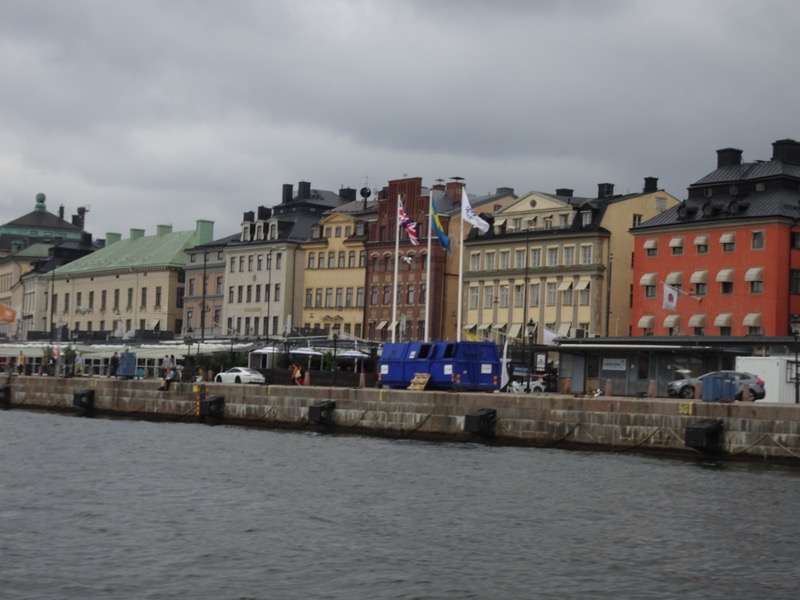 Many Swedes (like Norwegians) take the annual holidays in July. They tend not to travel far from home and like to go to their family holiday homes in the archipelagos. One in six Stockholmers owns a boat primarily for use during the summer – all of which are lifted out of the water at the end of August for the coming winter.
Many Swedes (like Norwegians) take the annual holidays in July. They tend not to travel far from home and like to go to their family holiday homes in the archipelagos. One in six Stockholmers owns a boat primarily for use during the summer – all of which are lifted out of the water at the end of August for the coming winter. These beautiful oxblood coloured buildings are very typical of this area, and the home range from mansion sized to cosy cottages.
These beautiful oxblood coloured buildings are very typical of this area, and the home range from mansion sized to cosy cottages. The large naval base located near the entrance to Stockholm’s CBD.
The large naval base located near the entrance to Stockholm’s CBD.

 The Tivoli fun park… that is one of those chair swing things, about 100′ off the ground. Not sure how fond I’d be of that plan!
The Tivoli fun park… that is one of those chair swing things, about 100′ off the ground. Not sure how fond I’d be of that plan! 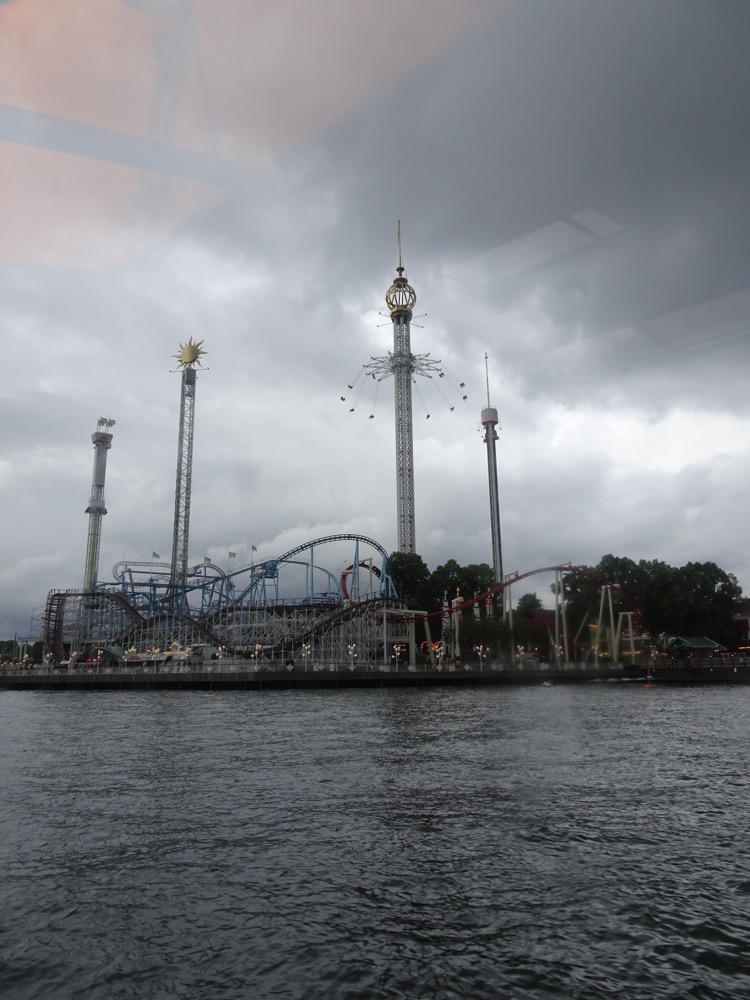
 The Vasa Museet, where we are headed for our conference dinner tonight. The Museum was built to cleverly show the size of the ship – when it sank, it went down in only 33m of water, leaving the main masts still present marking the spot. At the time, the shipbuilders fairly swiftly cut the masts for a variety of reasons, not the least of which was it sank in a busy waterway and they were a hazard, but also to remove the visual symbol of this huge seafaring failure. The museum designers Marianne Dahlbäck and Göran Månsson incorporated this fact into their architectural design showing on the outside of the museum just how much of the masts would have been visible after the Vasa sank.
The Vasa Museet, where we are headed for our conference dinner tonight. The Museum was built to cleverly show the size of the ship – when it sank, it went down in only 33m of water, leaving the main masts still present marking the spot. At the time, the shipbuilders fairly swiftly cut the masts for a variety of reasons, not the least of which was it sank in a busy waterway and they were a hazard, but also to remove the visual symbol of this huge seafaring failure. The museum designers Marianne Dahlbäck and Göran Månsson incorporated this fact into their architectural design showing on the outside of the museum just how much of the masts would have been visible after the Vasa sank.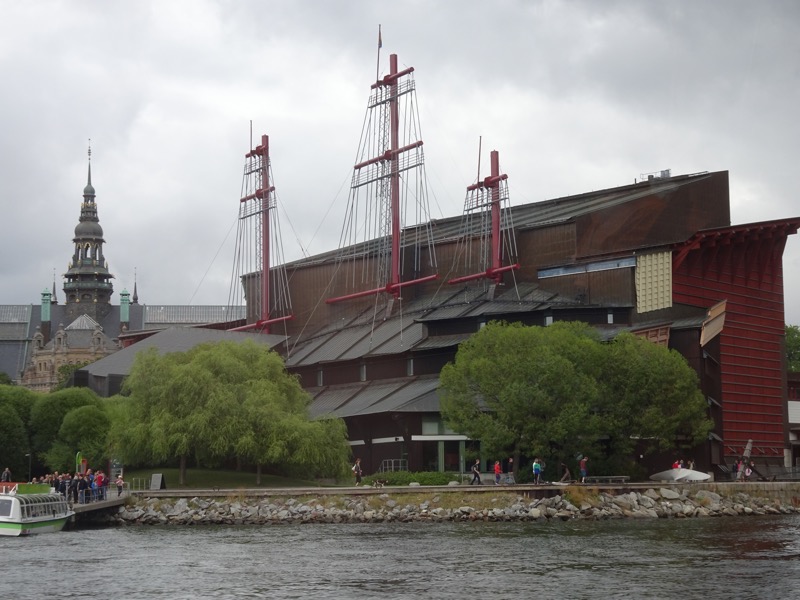
After our canal tour, we went back to our hotel to get cleaned up for the Conference dinner back at the Vasa. I have made two trips to the Vasa now and learned so much about the ship, that it too will be in a separate post so as not to clutter this day with a million photos.
The Vasa Museet is an amazing facility to have a dinner – I was sitting looking towards the ship throughout the function and could not believe I was 1) sipping champagne staring at a 300-year-old ship that had sunk, been excavated, resurrected, restored and placed in this amazing museum… and 2) doing so while surrounded by people who wanted to talk about transport policy, disruptive technologies in the transport sector, demand responsive transport, bus contracts and taxi innovation. DO THEY NOT SEE THE ENORMOUSLY IMPRESSIVE WARSHIP LOOMING OVER THEM? 😀 Sigh… I guess not everyone is as interested in history as I am. 
 I have included some photos of the ship here – but will add a whole pile of history and detail in a future post.
I have included some photos of the ship here – but will add a whole pile of history and detail in a future post. 

 The impressa of the Vasa family…
The impressa of the Vasa family…



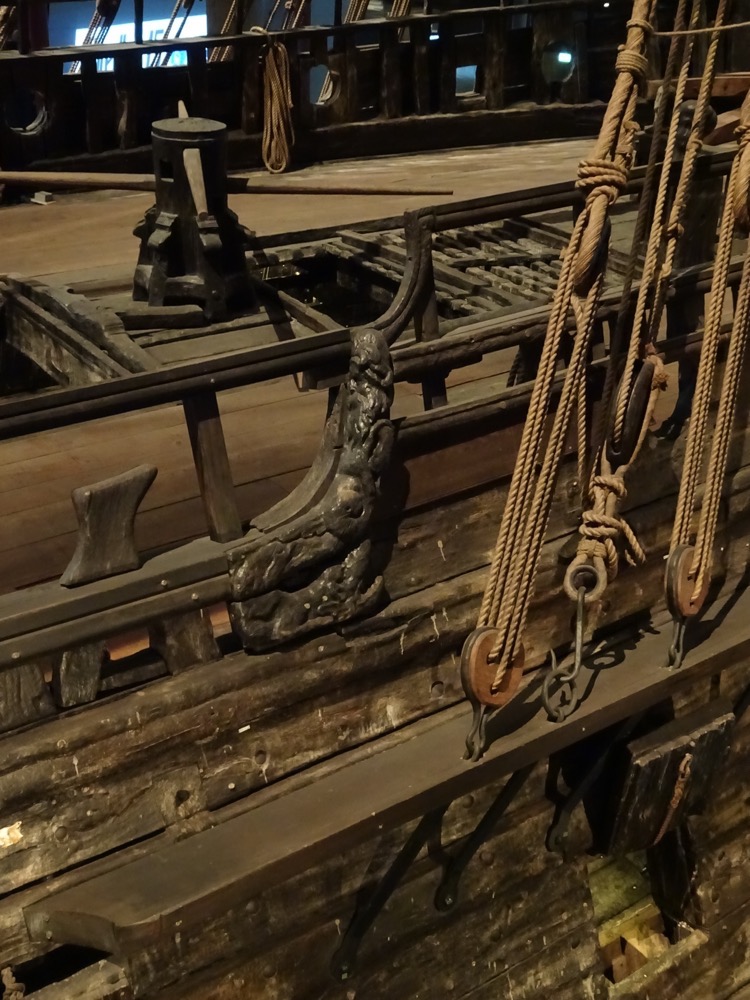
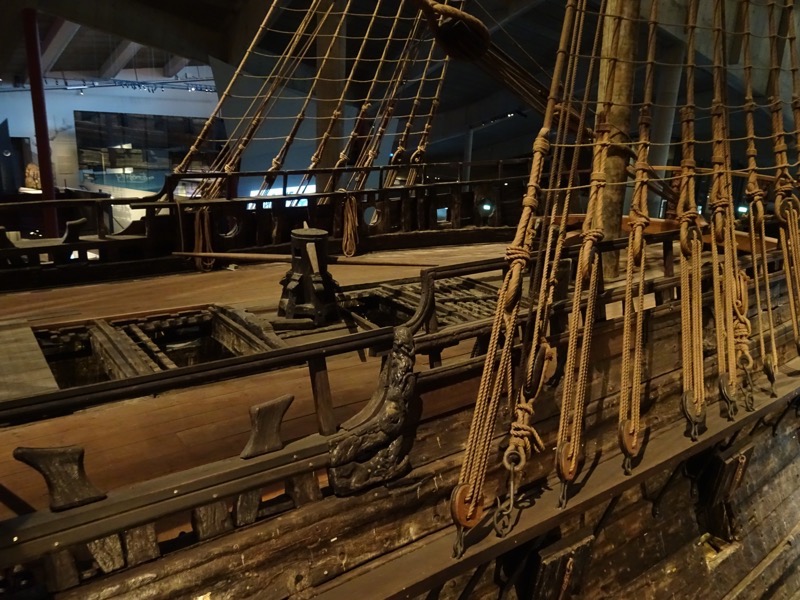

 Our tables for the reception.
Our tables for the reception.
 The function went over very well. Speeches were made, organizers were thanked, the next Thredbo was announced to be in Singapore in two years time. Overall, it was an amazing evening, and future conference organizers will be hard pressed to top it.
The function went over very well. Speeches were made, organizers were thanked, the next Thredbo was announced to be in Singapore in two years time. Overall, it was an amazing evening, and future conference organizers will be hard pressed to top it.


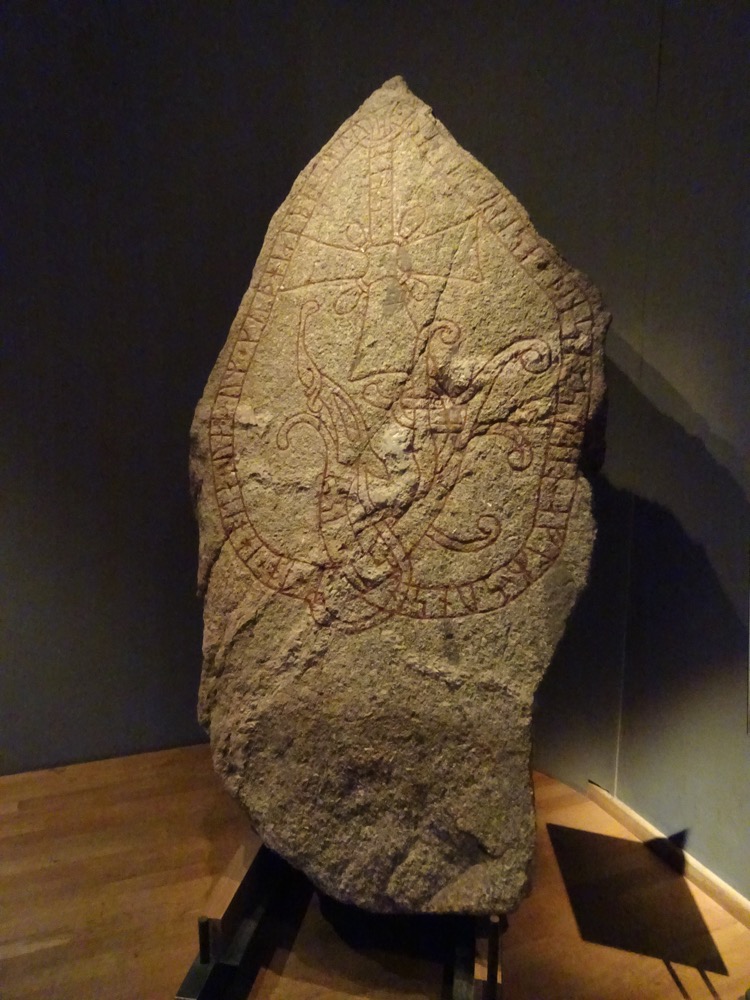

 Over 1,000 Viking Age silver hoards have been found in Sweden. One of the largest hoards was from Sigsarve, on Gotland Island and weighs in at six kilos of silver objects. The hoard may have been intended as some sort of payment in the form of jewellery as silver weight, as items are either whole or hacked to pieces There were 1,382 coins in the hoard as well – interestingly the majority of them are of Islamic origins.
Over 1,000 Viking Age silver hoards have been found in Sweden. One of the largest hoards was from Sigsarve, on Gotland Island and weighs in at six kilos of silver objects. The hoard may have been intended as some sort of payment in the form of jewellery as silver weight, as items are either whole or hacked to pieces There were 1,382 coins in the hoard as well – interestingly the majority of them are of Islamic origins. Penannular brooches from the Sigsarve hoard. 10thC to early 11thC, Gotland
Penannular brooches from the Sigsarve hoard. 10thC to early 11thC, Gotland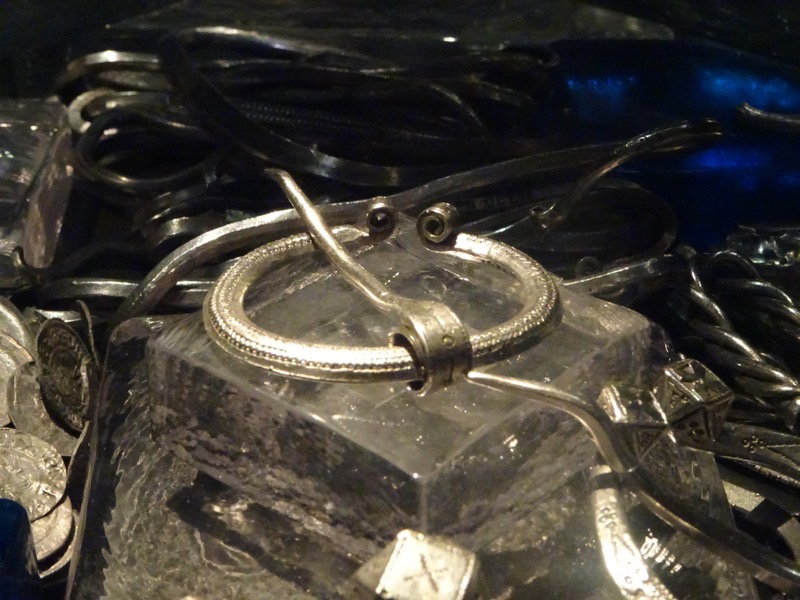



 Viking treasure found on the outskirts of Stockholm, Varby.
Viking treasure found on the outskirts of Stockholm, Varby.
 Viking era swords:
Viking era swords: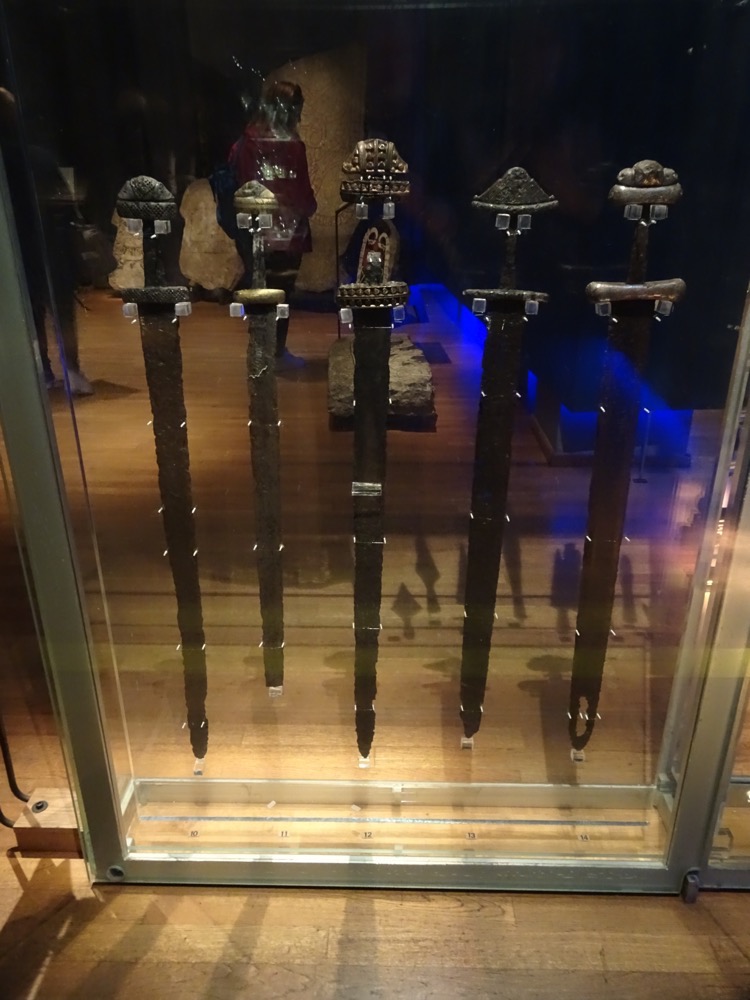

 She wore a key, clearly visible on the outside of her dress showing her control on the estate. She managed the resources and facilitated the generosity that was important to the family maintaining status and subsequently, control.
She wore a key, clearly visible on the outside of her dress showing her control on the estate. She managed the resources and facilitated the generosity that was important to the family maintaining status and subsequently, control. Blackware jug from Rhine region, originally with foil decoration, from Birka.
Blackware jug from Rhine region, originally with foil decoration, from Birka. Inviting guests to lavish feasts was a feature of high society in the Viking era. Such feasting was an important part of the aristocracy’s lifestyle. Funnel glasses from the Frankish realm were apt for displaying wealth at such feasts. Other luxurious and delicate glass artefacts were also found, such as bowls from Persia, and game pieces.
Inviting guests to lavish feasts was a feature of high society in the Viking era. Such feasting was an important part of the aristocracy’s lifestyle. Funnel glasses from the Frankish realm were apt for displaying wealth at such feasts. Other luxurious and delicate glass artefacts were also found, such as bowls from Persia, and game pieces. Glass gaming pieces, Birka.
Glass gaming pieces, Birka.
 Necklace, silver and rock crystal, Gotland, Lye.
Necklace, silver and rock crystal, Gotland, Lye.
 This petroglyph from the island of Gotland shows several people with drinking horns. During the Viking Age, alcoholic drinks were brewed – most popular were mead and ale. This stone depects men drinking and below, battling with swords.
This petroglyph from the island of Gotland shows several people with drinking horns. During the Viking Age, alcoholic drinks were brewed – most popular were mead and ale. This stone depects men drinking and below, battling with swords. Picture stone, from Lillbjars, Gotland may have been part of a coffin lid.
Picture stone, from Lillbjars, Gotland may have been part of a coffin lid.

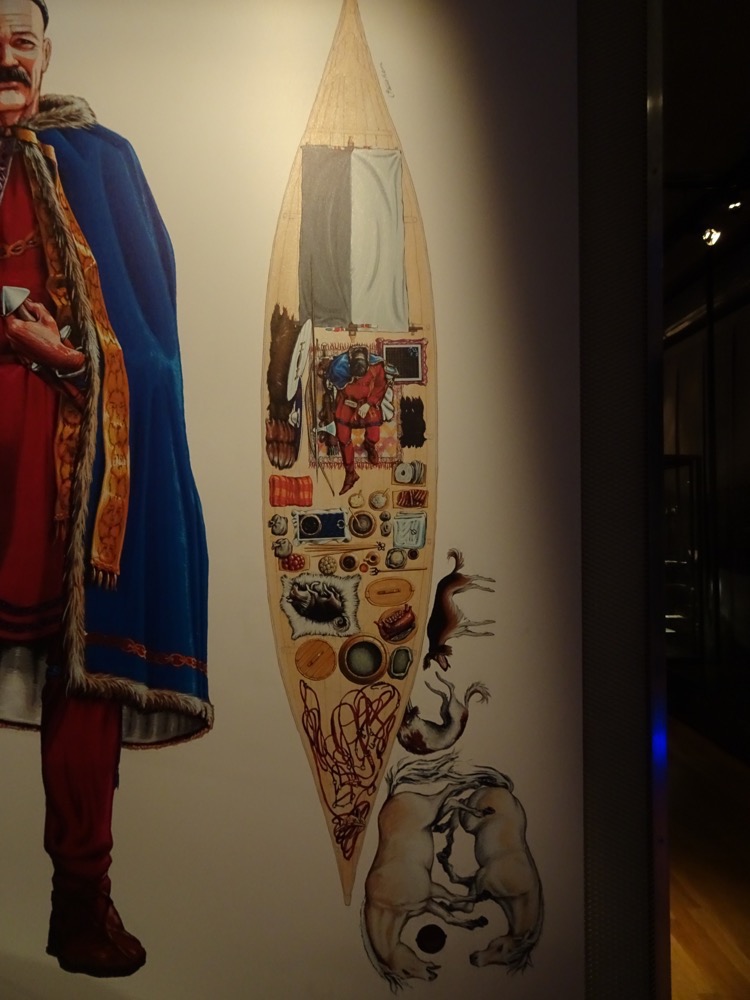 Vendel Magnate: From a powerful clan in Uppland, he is dressed in his most luxurious clothes and dress accessories. This baron was buried in his ship, along with his most valuable possessions including an iron cauldron, a meat fork, gaming pieces, an axe, a spear, arrow heads, shield bosses and a seax. This image shows his grave as it was found.
Vendel Magnate: From a powerful clan in Uppland, he is dressed in his most luxurious clothes and dress accessories. This baron was buried in his ship, along with his most valuable possessions including an iron cauldron, a meat fork, gaming pieces, an axe, a spear, arrow heads, shield bosses and a seax. This image shows his grave as it was found.
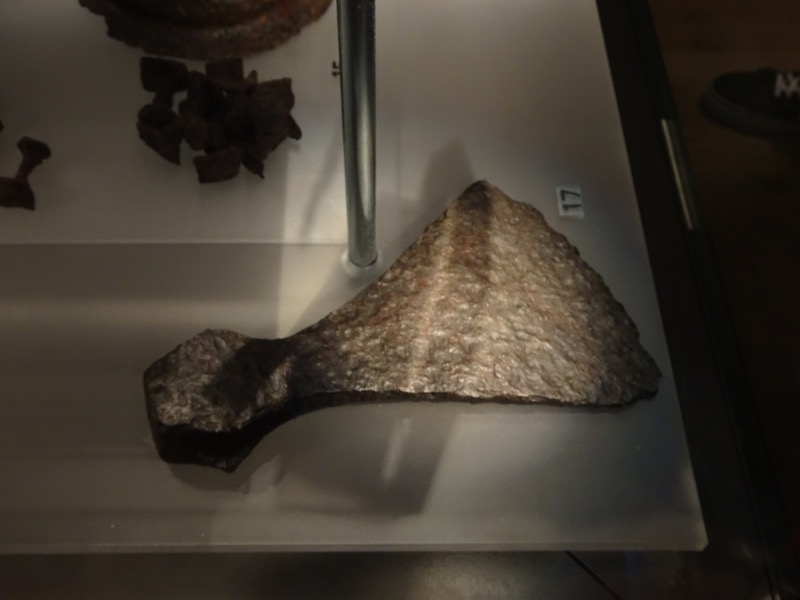
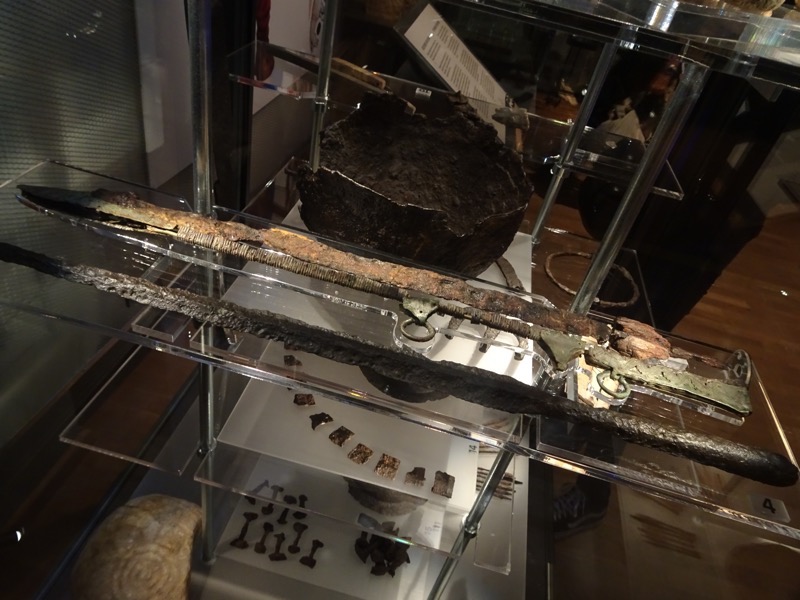
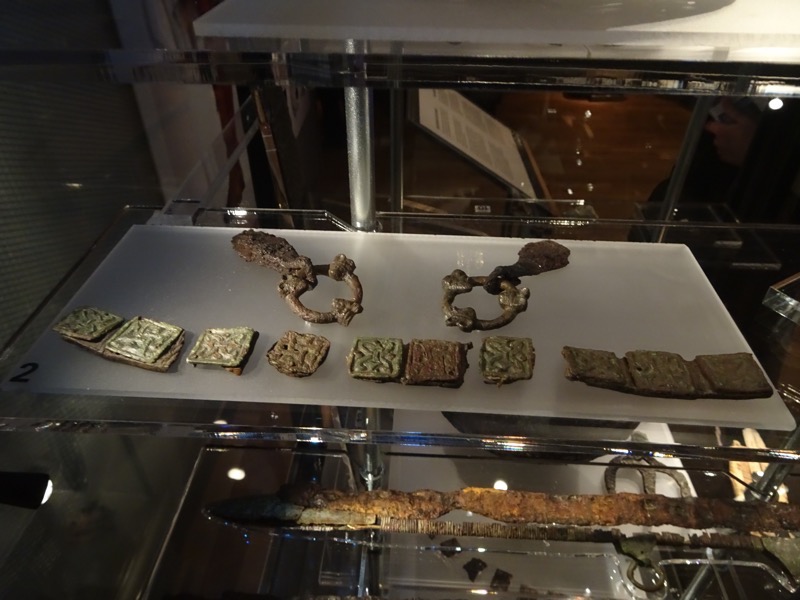



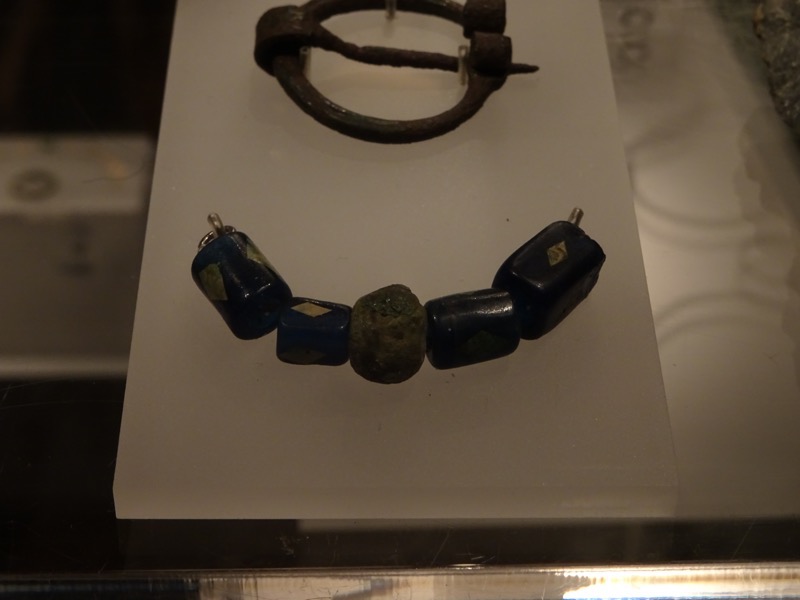





 Fittings from a Birka pouch.a
Fittings from a Birka pouch.a

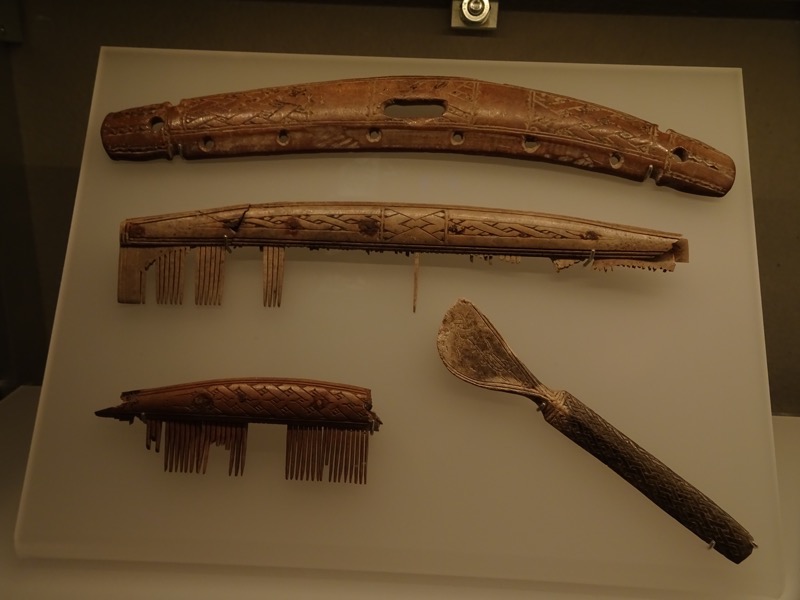


 Collection of tools found in a tool chest – fire, grid and iron tools (plate shears hacksaw, keys and nail irons), Gotland, Mastermyr.
Collection of tools found in a tool chest – fire, grid and iron tools (plate shears hacksaw, keys and nail irons), Gotland, Mastermyr.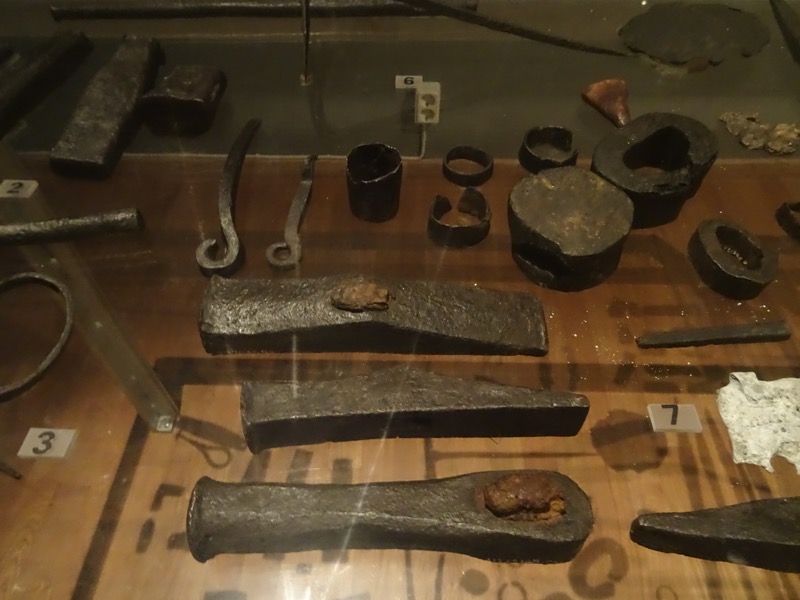
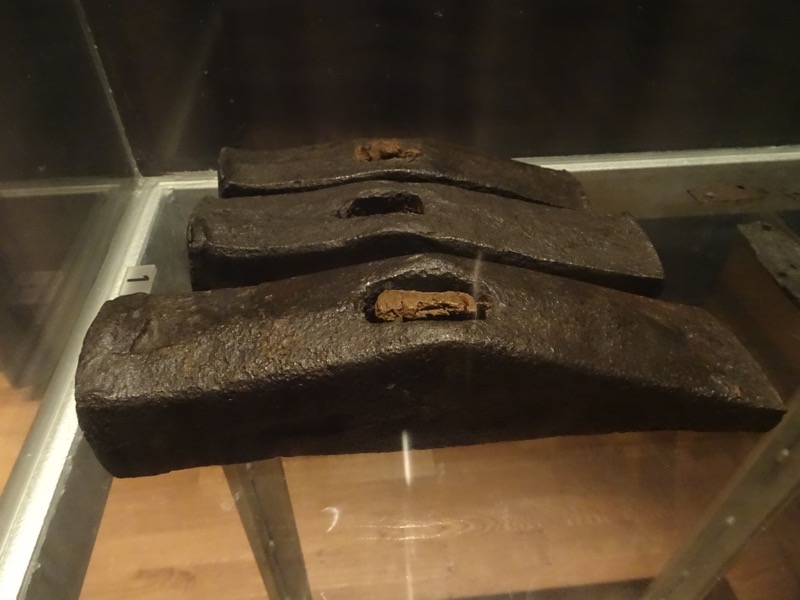



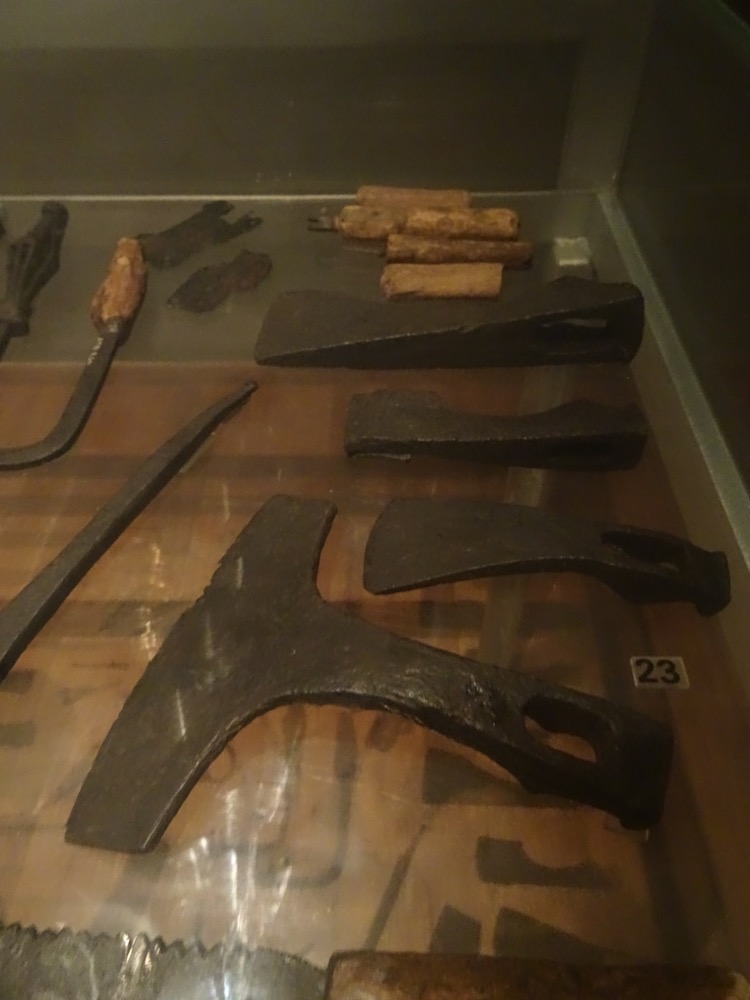 Silver brooch with relief ornamentation, Skane, Rinkaby.
Silver brooch with relief ornamentation, Skane, Rinkaby.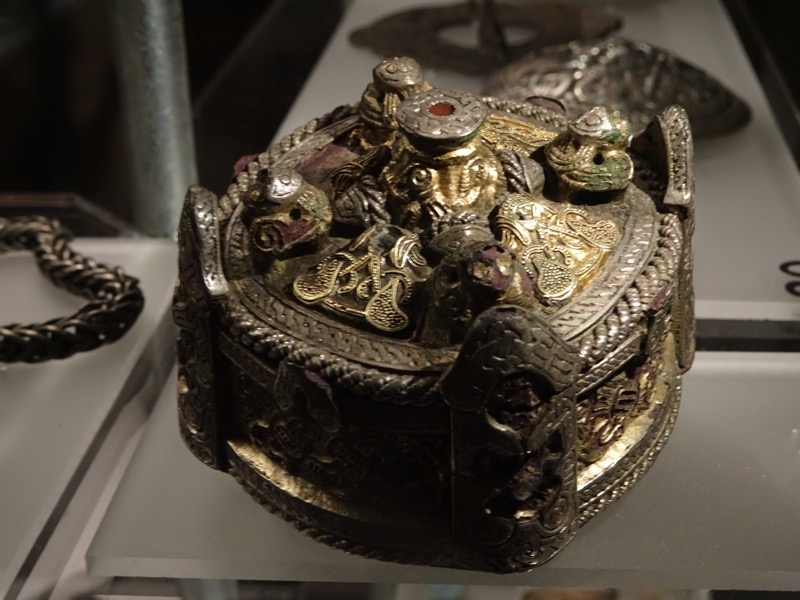
 Decorative bronze chains, Birka c.800AD
Decorative bronze chains, Birka c.800AD Women’s decorative dress brooches – approximately 12-15cm in length, bronze.
Women’s decorative dress brooches – approximately 12-15cm in length, bronze.


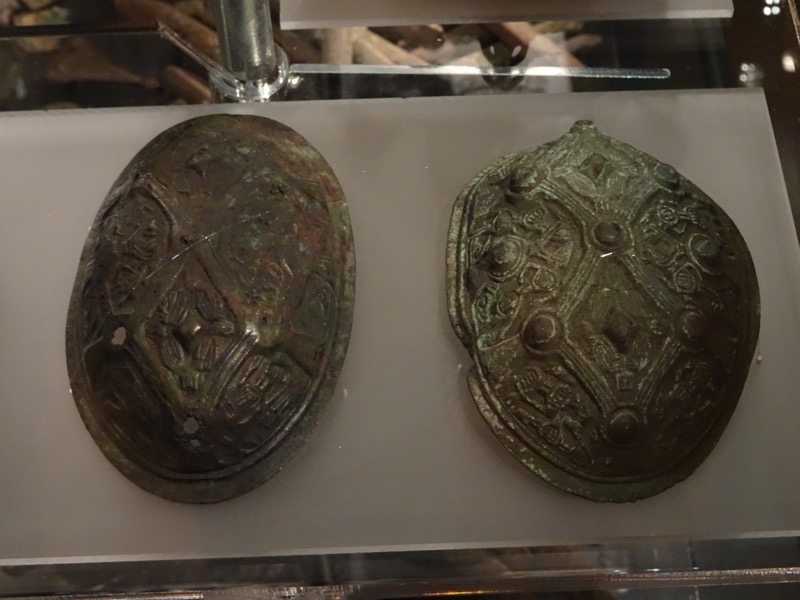









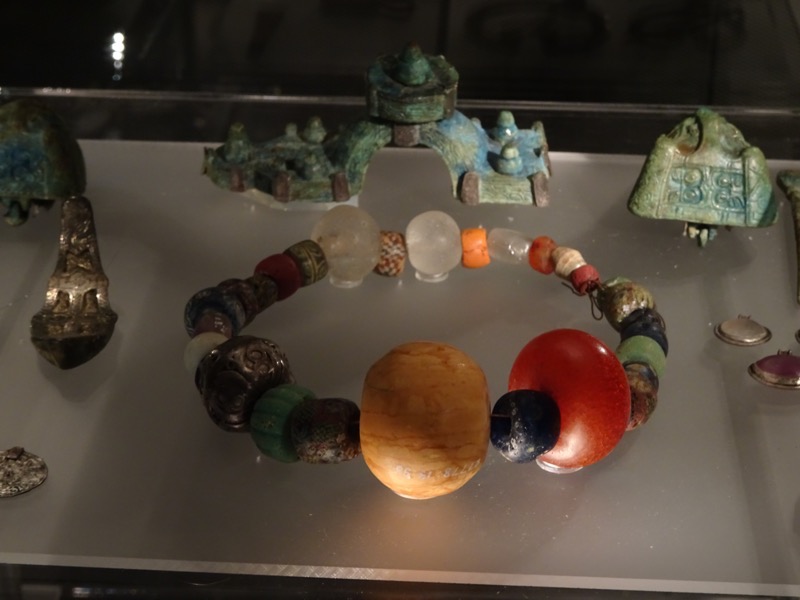
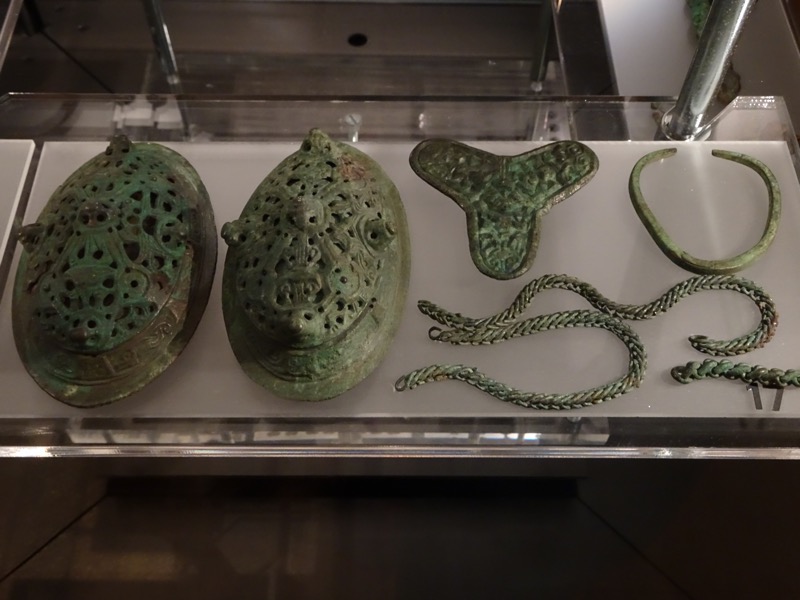

 Bronze hook keys, and chain for a woman’s dress, Gotland, Hemse.
Bronze hook keys, and chain for a woman’s dress, Gotland, Hemse.
 Similar women’s dress keys, much larger than expected. Key in bottom right, approx 10-11cm.
Similar women’s dress keys, much larger than expected. Key in bottom right, approx 10-11cm.

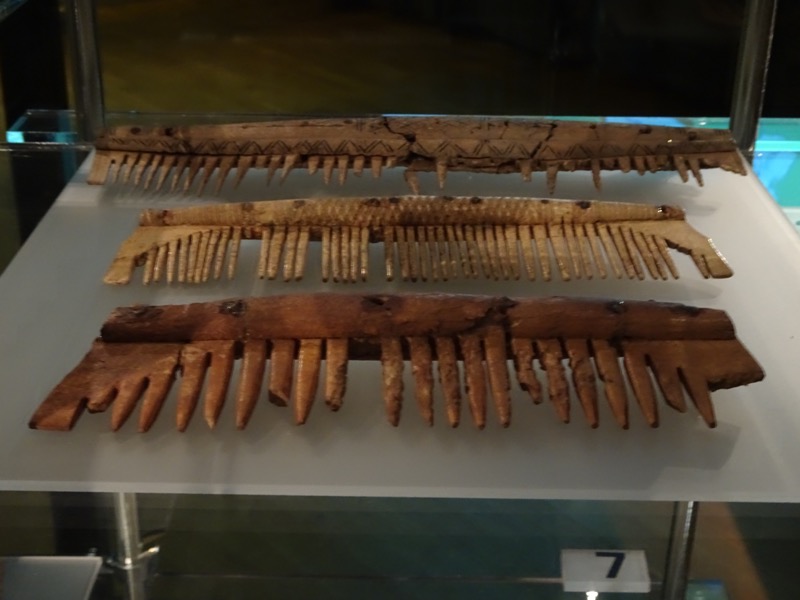 Reconstruction of viking men’s clothing..
Reconstruction of viking men’s clothing.. Reconstruction of women’s clothing…
Reconstruction of women’s clothing…
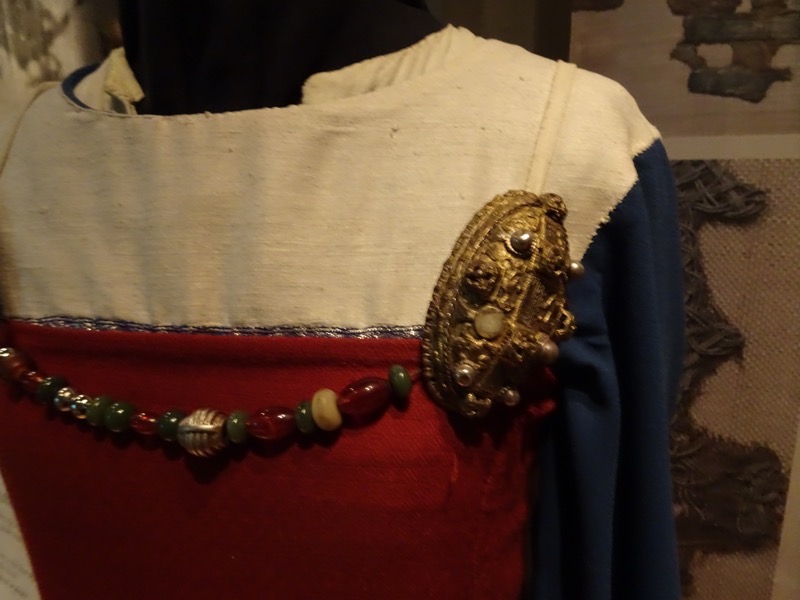

 The district of Dalarna and adjacent provinces to the north were centres for the important iron trade, with routes going past lake Siljan. Many valuable iron objects are evident among grave finds from this region, including Solleron.
The district of Dalarna and adjacent provinces to the north were centres for the important iron trade, with routes going past lake Siljan. Many valuable iron objects are evident among grave finds from this region, including Solleron.
 Children’s bell – approximately 2.5 – 3.0cm in diameter. Many other examples roughly 2cm in size.
Children’s bell – approximately 2.5 – 3.0cm in diameter. Many other examples roughly 2cm in size. The Ruler of Oland: A burial grave of regal splendour was found in Kopingsvik on the Island of Oland. She was buried with a staff made of iron and bronze, indicating her religious position as an Old Norse female cult leader, called a Volur, meaning ‘staff carrier’. She would have been the leader of a very wealthy clan on Oland, perhaps the most powerful on the island.
The Ruler of Oland: A burial grave of regal splendour was found in Kopingsvik on the Island of Oland. She was buried with a staff made of iron and bronze, indicating her religious position as an Old Norse female cult leader, called a Volur, meaning ‘staff carrier’. She would have been the leader of a very wealthy clan on Oland, perhaps the most powerful on the island.
 Reconstruced ‘throne’ of the Ruler of Oland.
Reconstruced ‘throne’ of the Ruler of Oland.






 In eastern Scandinavia, the spread of Christianity varied from district to district. This display is of finds from the Garda cemetery on Gotland Island. Christian graves did not generally reveal as many artefacts as a pagan Viking grave.
In eastern Scandinavia, the spread of Christianity varied from district to district. This display is of finds from the Garda cemetery on Gotland Island. Christian graves did not generally reveal as many artefacts as a pagan Viking grave. Displaced items: This crozier was found on Helgo Island – it is from Ireland and contains a Buddha figurine from India. Additionally, in the same Viking long hall on Helgo Island, a ladle from the Eastern Mediterranean was found as well… Archeologist have determined that the Buddha is 6thC Indian in origin, coiled in the top of a crozier that was made in Ireland c800AD. It may be related to the Coptic Christian Church and the objects may have arrived on Helgo Island as exclusive aristocratic gifts or pillaged goods.
Displaced items: This crozier was found on Helgo Island – it is from Ireland and contains a Buddha figurine from India. Additionally, in the same Viking long hall on Helgo Island, a ladle from the Eastern Mediterranean was found as well… Archeologist have determined that the Buddha is 6thC Indian in origin, coiled in the top of a crozier that was made in Ireland c800AD. It may be related to the Coptic Christian Church and the objects may have arrived on Helgo Island as exclusive aristocratic gifts or pillaged goods. Mediterranean ladle found in a Viking long hall site on Helgo Island.
Mediterranean ladle found in a Viking long hall site on Helgo Island.
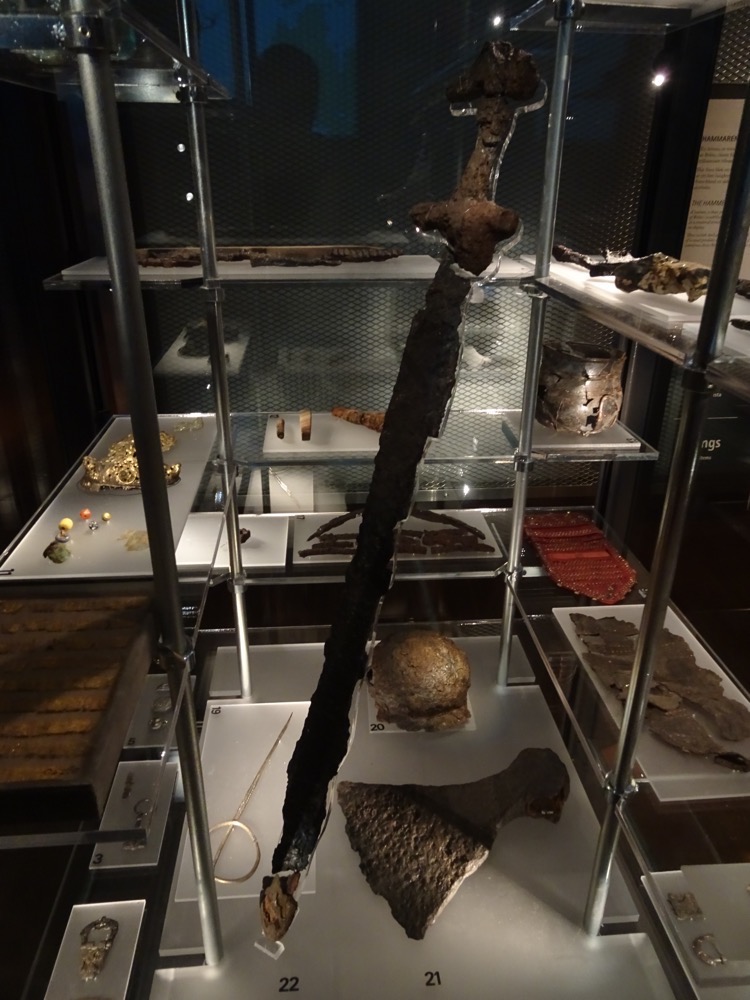
 Baptismal font from Norum, Bohuslan province. The image etched on the font depicts Gunnar in the snake pit – a scene from the famed Volsunga Saga; demonstrating that the early Christian church blended heathen myths with Christian precepts. The rune text reads “Sven made me”
Baptismal font from Norum, Bohuslan province. The image etched on the font depicts Gunnar in the snake pit – a scene from the famed Volsunga Saga; demonstrating that the early Christian church blended heathen myths with Christian precepts. The rune text reads “Sven made me”





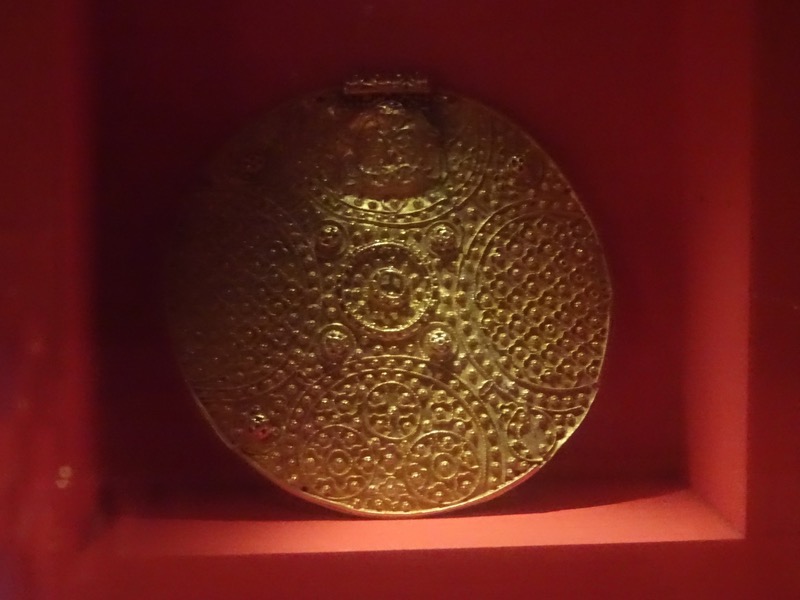


 Brooch from a na’s grave, Uppland (Brondkyrko), Haga, c.1100-900BC
Brooch from a na’s grave, Uppland (Brondkyrko), Haga, c.1100-900BC Gold bow, Blekinge, Nattraby/Skrea. 1100-900 BC.
Gold bow, Blekinge, Nattraby/Skrea. 1100-900 BC. Gold bracteate with Aesir saga motif (Tyr and the Fenriswolf), Trollhattan, 400-500AD.
Gold bracteate with Aesir saga motif (Tyr and the Fenriswolf), Trollhattan, 400-500AD. Valkyrie pendant,Oland,Koping, 800-1050AD.
Valkyrie pendant,Oland,Koping, 800-1050AD. Silver crucifix, Uppland, Adelso, Birka, c.800-1050.
Silver crucifix, Uppland, Adelso, Birka, c.800-1050.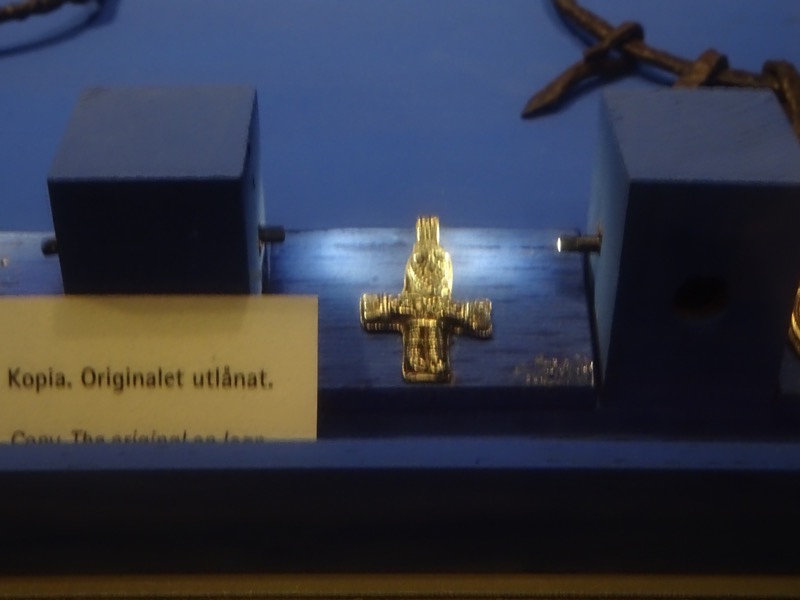 Thor’s hammer, gilded pendant, Odeshog, c.800-1050AD
Thor’s hammer, gilded pendant, Odeshog, c.800-1050AD



 Arm ring made of gold from Skane, Glostorp, Kaglinge, c.400AD
Arm ring made of gold from Skane, Glostorp, Kaglinge, c.400AD Twisted gold bracelet, Sodermanland, Vanso c.800-1050AD
Twisted gold bracelet, Sodermanland, Vanso c.800-1050AD Relief buckles made of gilded silver from Oland, c.400-550AD
Relief buckles made of gilded silver from Oland, c.400-550AD Relief buckle and buttons made of gilded bronze with garnet inlay, from Vastmanland, Tortuna, Nicktuna, c.400-550AD
Relief buckle and buttons made of gilded bronze with garnet inlay, from Vastmanland, Tortuna, Nicktuna, c.400-550AD Iron and bronze helmet, Uppland, Vendel, c.550-800AD
Iron and bronze helmet, Uppland, Vendel, c.550-800AD
 Gold bracelets with terminal animal heads. Oland, As, c.400AD.
Gold bracelets with terminal animal heads. Oland, As, c.400AD.

 Finely decorated gold charm beads, Vastergotland, Dalstorp, c.400AD.
Finely decorated gold charm beads, Vastergotland, Dalstorp, c.400AD. Gold collar, Vasergotland, Mone. 5th century.
Gold collar, Vasergotland, Mone. 5th century.
 Godl ring with carneol seting, Old Uppsala, Fullero, c400AD.
Godl ring with carneol seting, Old Uppsala, Fullero, c400AD.
 Finely decorated gold charm beads, Vastergotland, Dalstorp, c.400AD.
Finely decorated gold charm beads, Vastergotland, Dalstorp, c.400AD.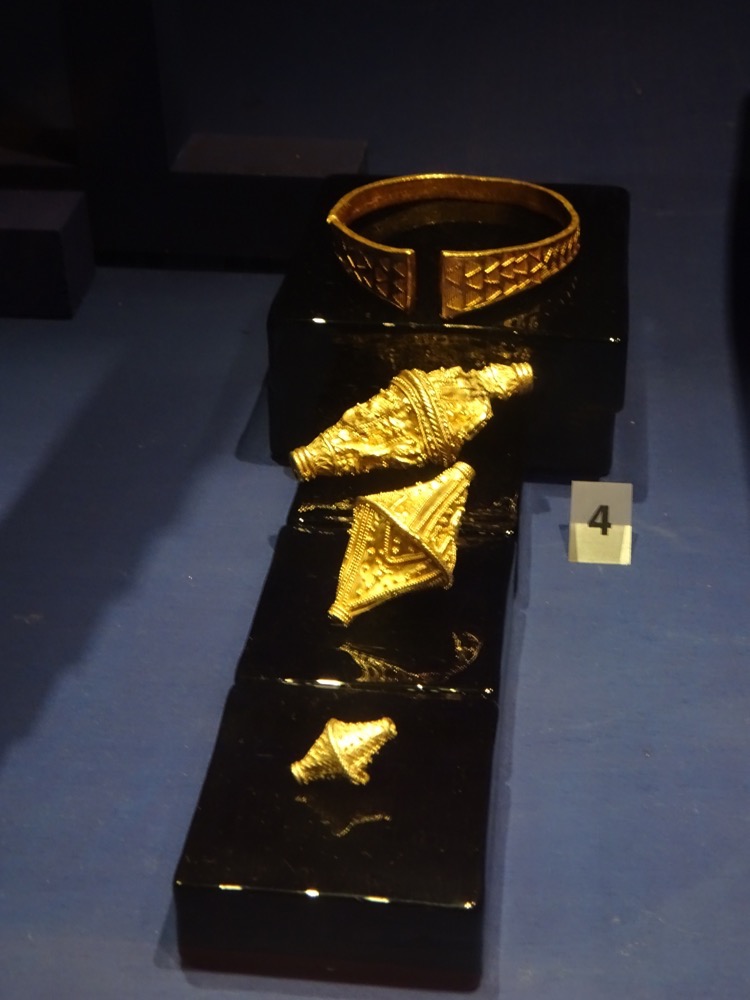
 Gold rings worn and used as currency, Gotland. c.8thC
Gold rings worn and used as currency, Gotland. c.8thC


 Sword with silver, copper and brass inlay, Gotland, Halla, c.800-1050AD
Sword with silver, copper and brass inlay, Gotland, Halla, c.800-1050AD
 Included as the most matching/symmetrical set of Viking beads I have ever seen… this pleases me and makes me think that somewhere, at some time in history, was a woman whose obsessive personality traits/tendencies were similar to my own. 😉
Included as the most matching/symmetrical set of Viking beads I have ever seen… this pleases me and makes me think that somewhere, at some time in history, was a woman whose obsessive personality traits/tendencies were similar to my own. 😉 



 Gold ornaments, Gotland, Labro, c.1000-1500AD
Gold ornaments, Gotland, Labro, c.1000-1500AD
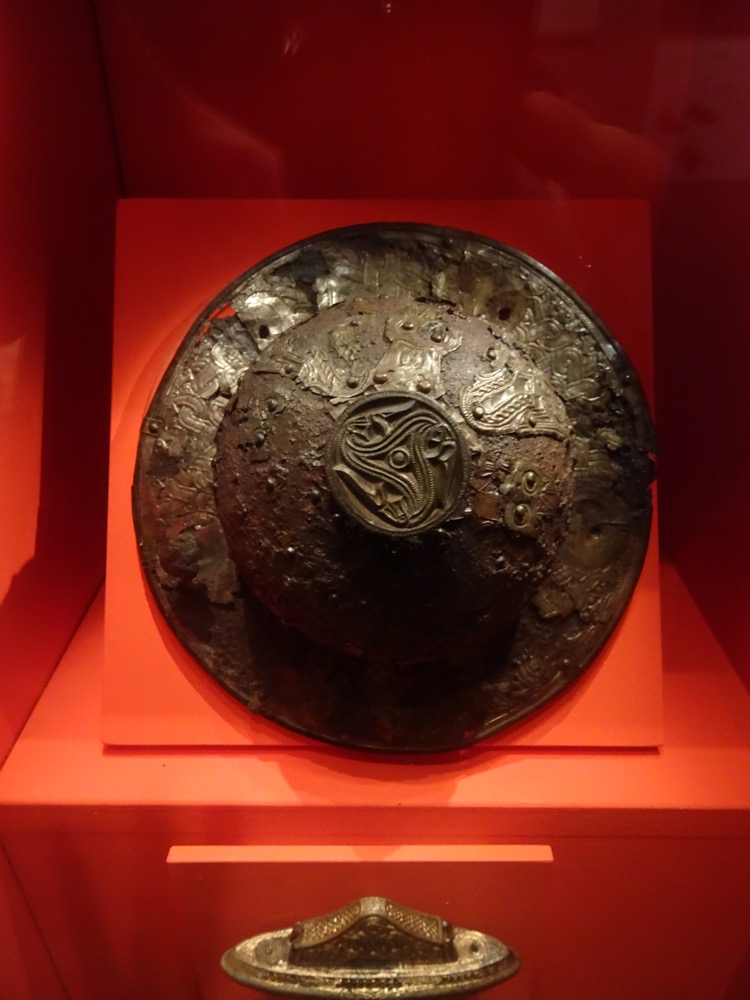






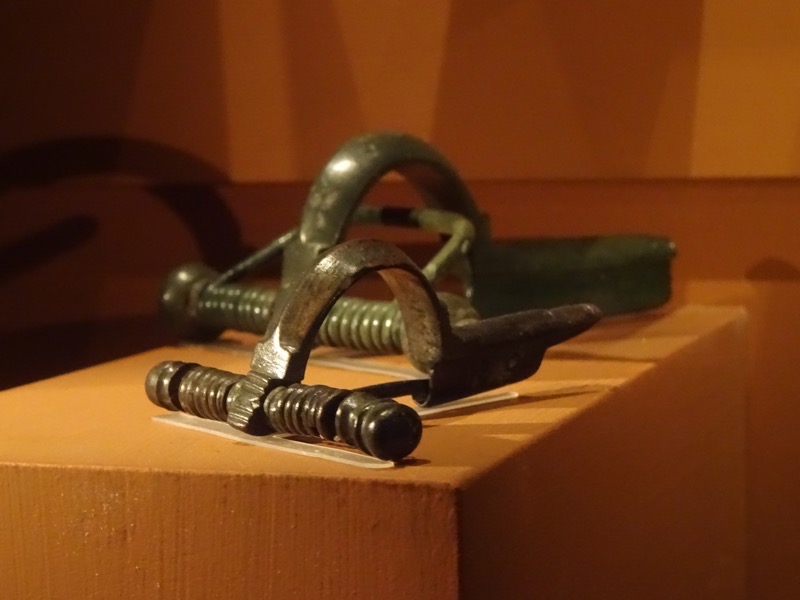








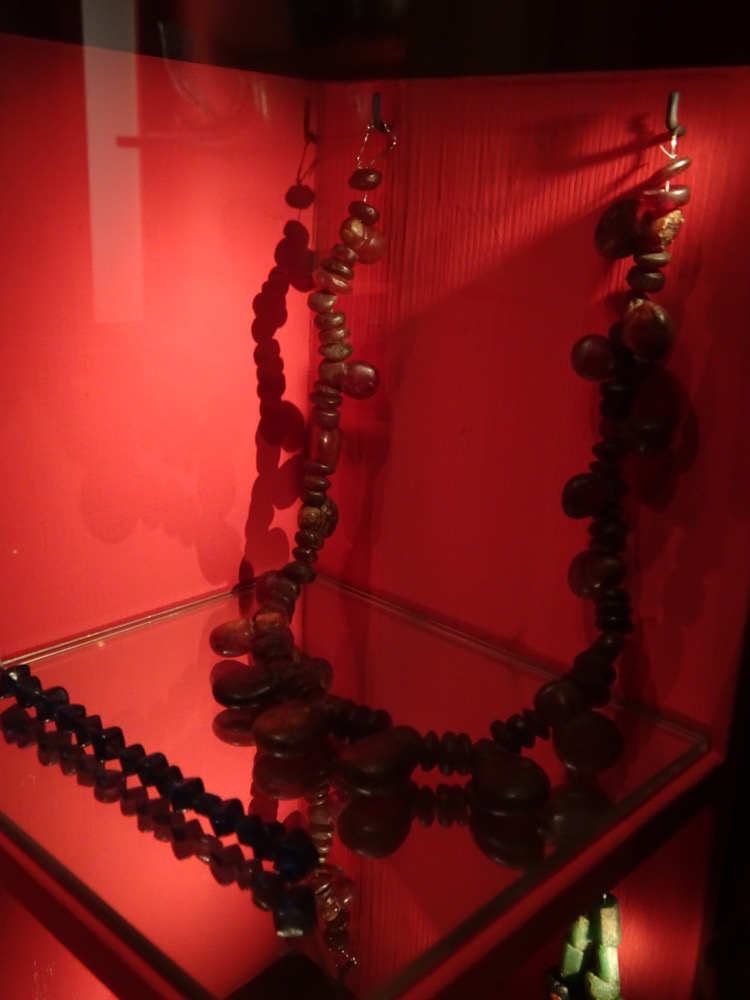




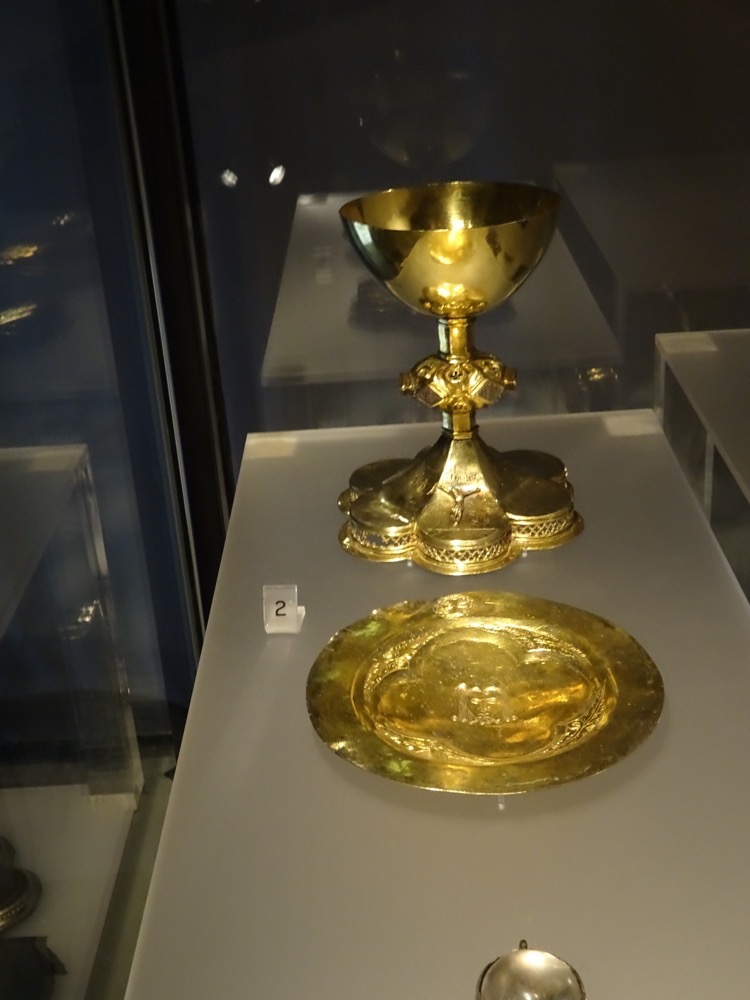
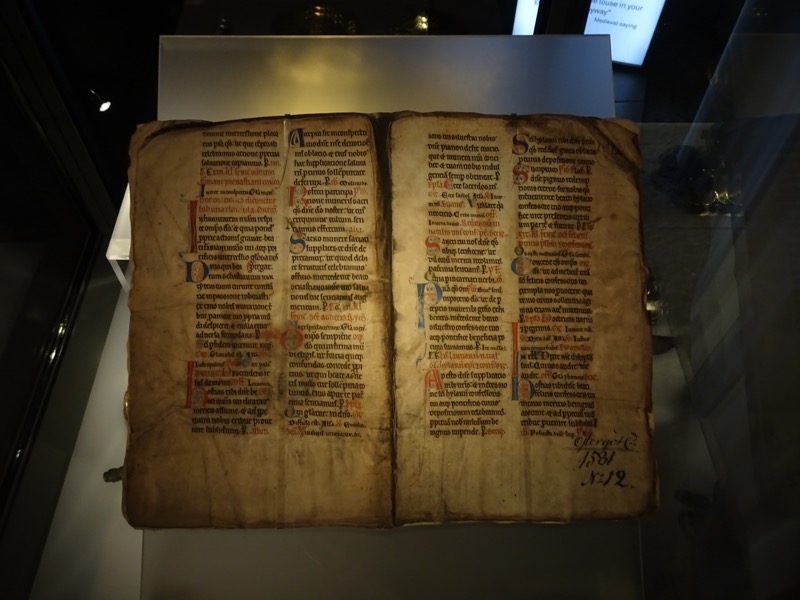 Impossible to photograph delicate filigree chain…
Impossible to photograph delicate filigree chain…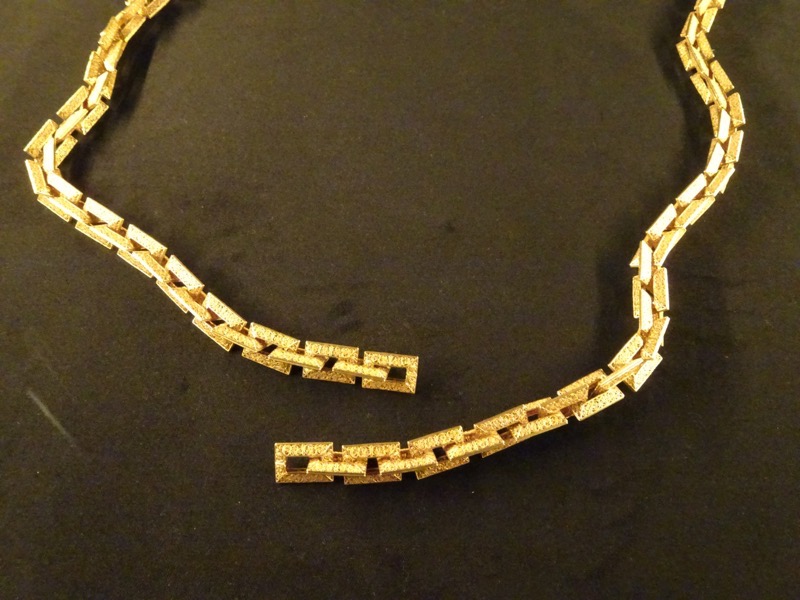
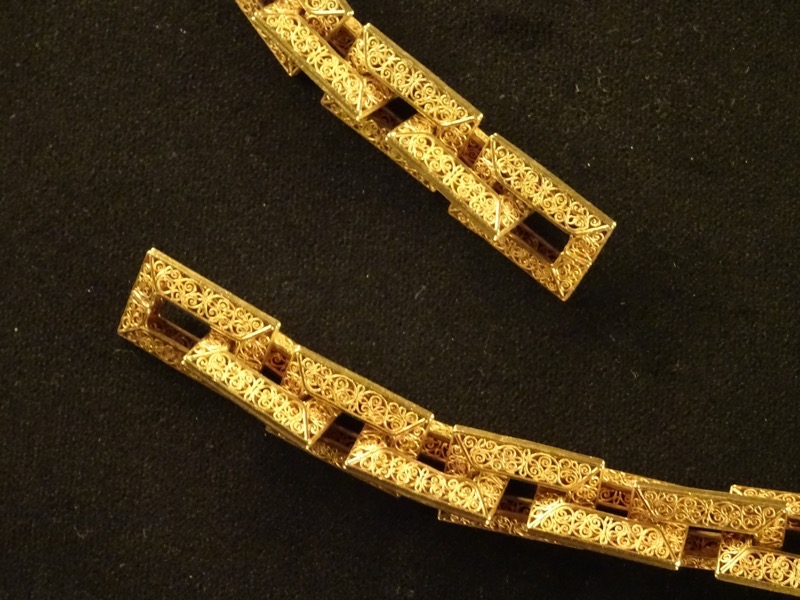
 Prayer book for Malin Sture, a young woman of a noble family in Sodermanland, Horningsholm, c.1599.
Prayer book for Malin Sture, a young woman of a noble family in Sodermanland, Horningsholm, c.1599. Jewelled pendant owned by Queen Maria Eleanora (1599-1655).
Jewelled pendant owned by Queen Maria Eleanora (1599-1655).


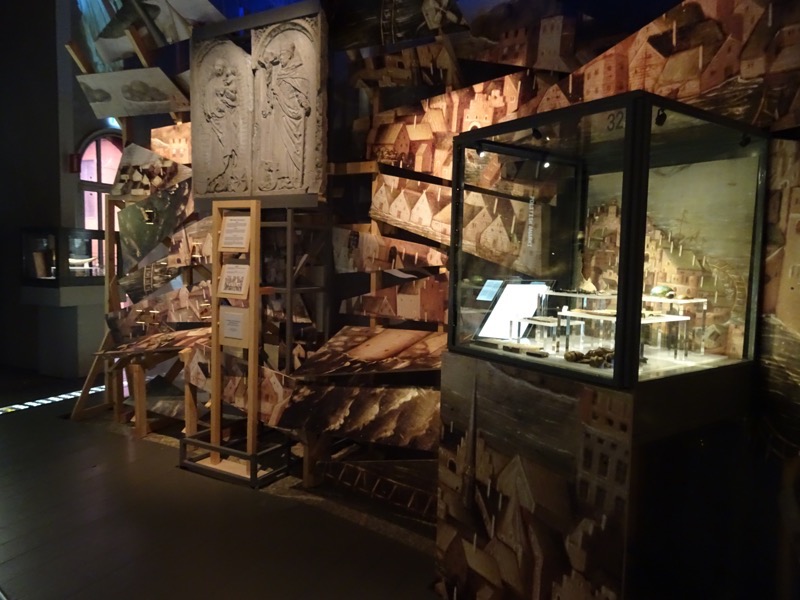

 Everyday objects from the medieval town strata in Uppsala and Strngnas – a child’s shoe, a casing mould and a book cover 1100-1500AD.
Everyday objects from the medieval town strata in Uppsala and Strngnas – a child’s shoe, a casing mould and a book cover 1100-1500AD.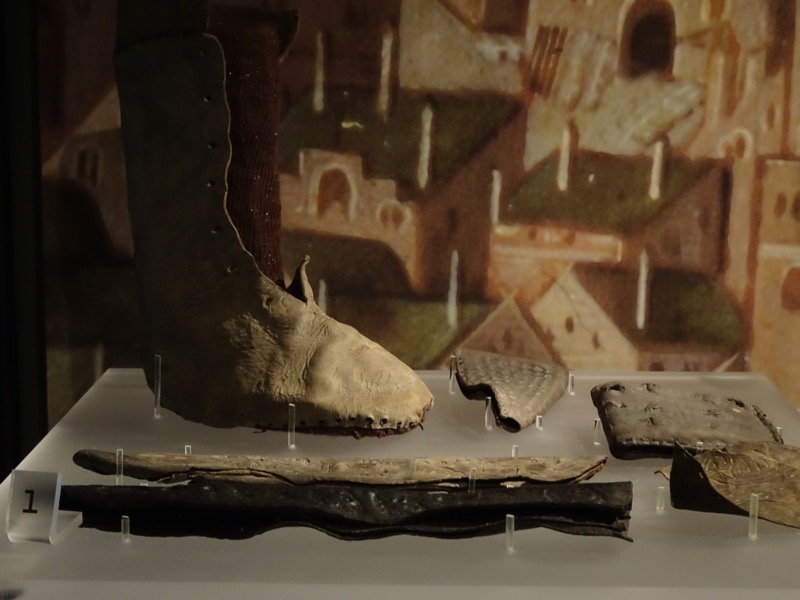


 Silver gilt goblet for King Karl Knutsson Bonde, Vastmanland, Angso Castle, 1468-1470.
Silver gilt goblet for King Karl Knutsson Bonde, Vastmanland, Angso Castle, 1468-1470.
 Reconstruction of Qeuun Marget’s gown – the original woven of cloth of gold, belongs to Uppsala Cathedral Museum, c15th century.
Reconstruction of Qeuun Marget’s gown – the original woven of cloth of gold, belongs to Uppsala Cathedral Museum, c15th century.
 St Briget – details of the altarpiece, depicting different ages of Briget. Ostergotland, Appuna Church, 1450-1475.
St Briget – details of the altarpiece, depicting different ages of Briget. Ostergotland, Appuna Church, 1450-1475.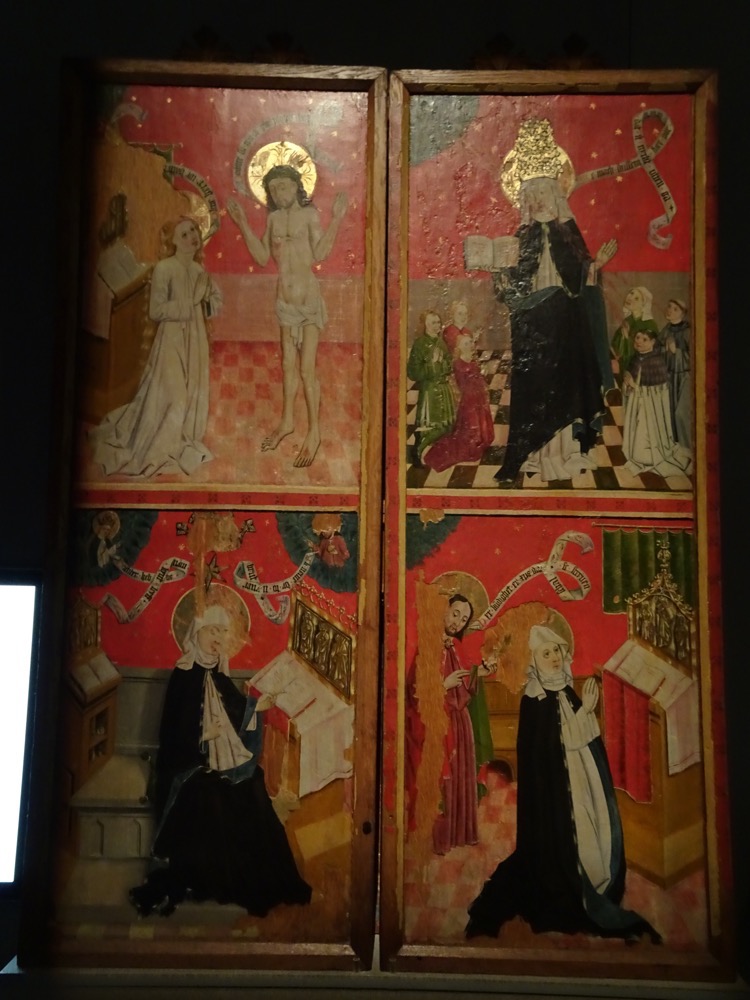




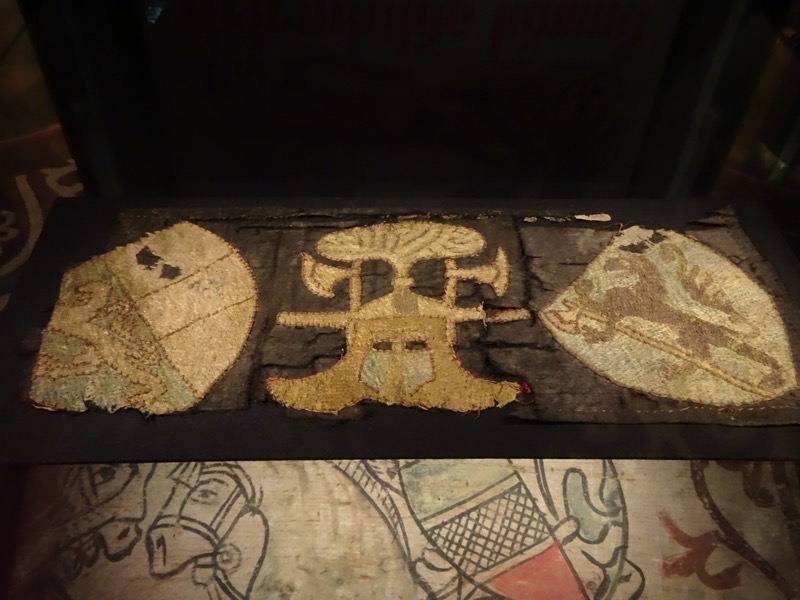
 Broadleaf-wood drinking horn. Uppland c.1300-1400AD.
Broadleaf-wood drinking horn. Uppland c.1300-1400AD. Oak reliquary, overdrawn with gilded copper, Vastergotland, Eriksberg Church, c.1175AD
Oak reliquary, overdrawn with gilded copper, Vastergotland, Eriksberg Church, c.1175AD

 This was the Stock Exchange Building, before becoming the Nobel Museum.
This was the Stock Exchange Building, before becoming the Nobel Museum. 

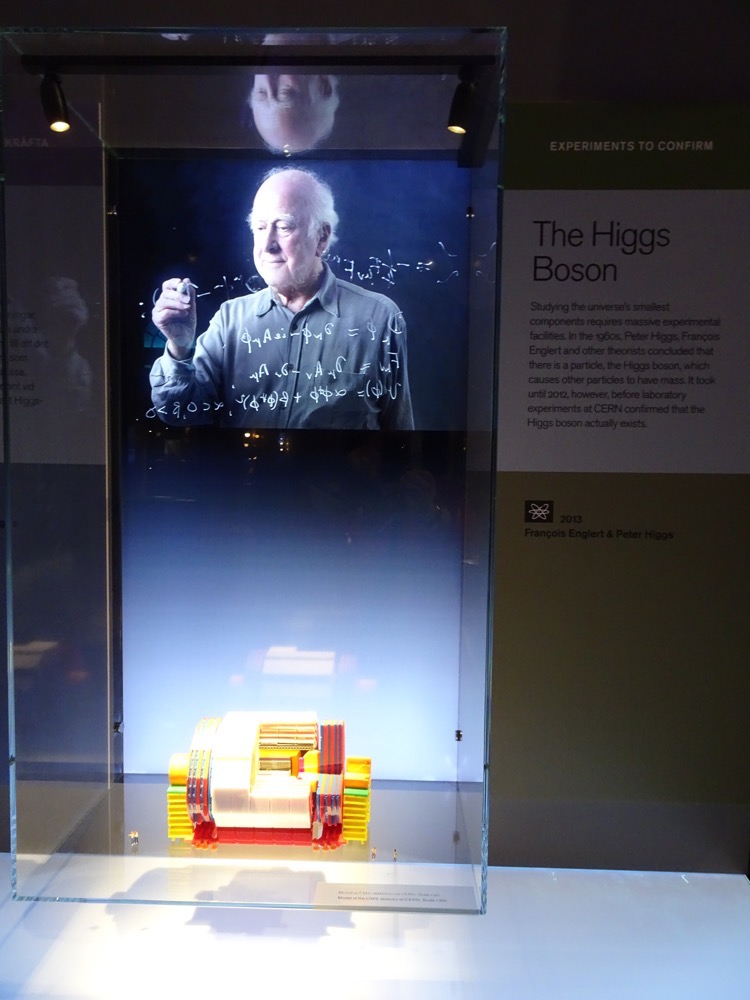 Around the corner is the Royal Palace – Kungliga Slottet. While the Swedish royal family actually reside now at the Drottningholm Palace, all the offices of the Royal Court of Sweden are located here, and all royal duties performed by King Carl XVI and Queen Silvia as heads of state are performed here.
Around the corner is the Royal Palace – Kungliga Slottet. While the Swedish royal family actually reside now at the Drottningholm Palace, all the offices of the Royal Court of Sweden are located here, and all royal duties performed by King Carl XVI and Queen Silvia as heads of state are performed here.

 The main entrance hall.
The main entrance hall. Audience chamber.
Audience chamber.
 The Apartments of the Orders of Chivalry
The Apartments of the Orders of Chivalry
 Random bit of wall panelling…
Random bit of wall panelling… Probably affectionately refered to as the Blue Room, the Red Room and the Green Room, the Apartments of the Orders of Chivalry are decked out with displays of regalia – uniforms and fealty chains (dating from the 18th-20thC).
Probably affectionately refered to as the Blue Room, the Red Room and the Green Room, the Apartments of the Orders of Chivalry are decked out with displays of regalia – uniforms and fealty chains (dating from the 18th-20thC).

 The detail is just astonishing!
The detail is just astonishing! Below is a display of every award bestowed on one Prince Bertil of Sweden, Duke of Halland and son of King Gustaf VI Adolf of Sweden and his first wife, Princess Margaret of Connaught (18 February 1912 to 5 January 1997). I guess that was the thing – bestow all the awards and favours on your family.
Below is a display of every award bestowed on one Prince Bertil of Sweden, Duke of Halland and son of King Gustaf VI Adolf of Sweden and his first wife, Princess Margaret of Connaught (18 February 1912 to 5 January 1997). I guess that was the thing – bestow all the awards and favours on your family. 

 I was unable to get a photo of the gold work on this vestment – it was seriously impressive though.
I was unable to get a photo of the gold work on this vestment – it was seriously impressive though.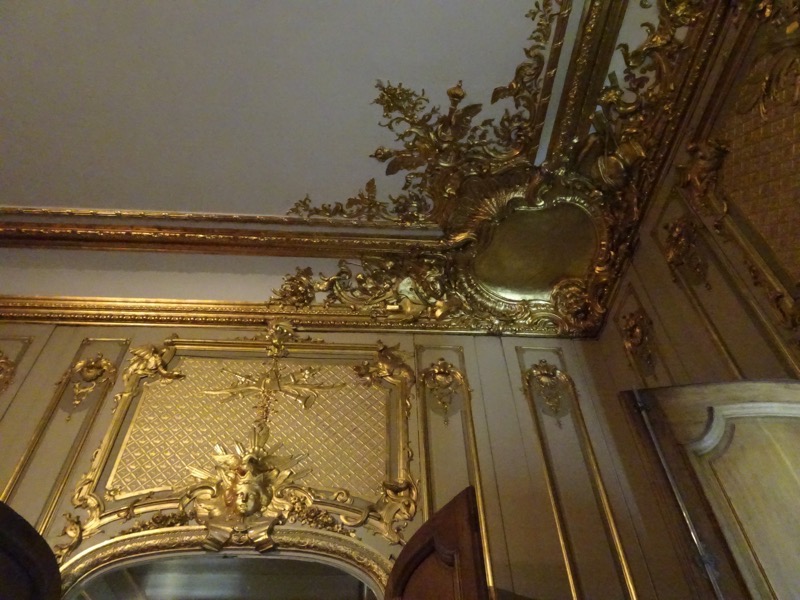 More crazy detail 20′ in the air. So much gilt!
More crazy detail 20′ in the air. So much gilt!

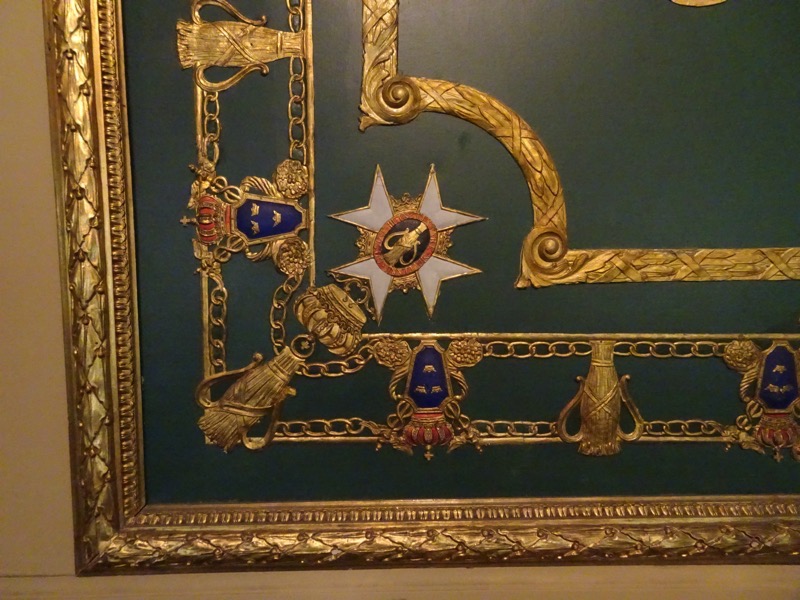
 Below: Fealty Chain of the Order of the Annunciation – c.1518.
Below: Fealty Chain of the Order of the Annunciation – c.1518.

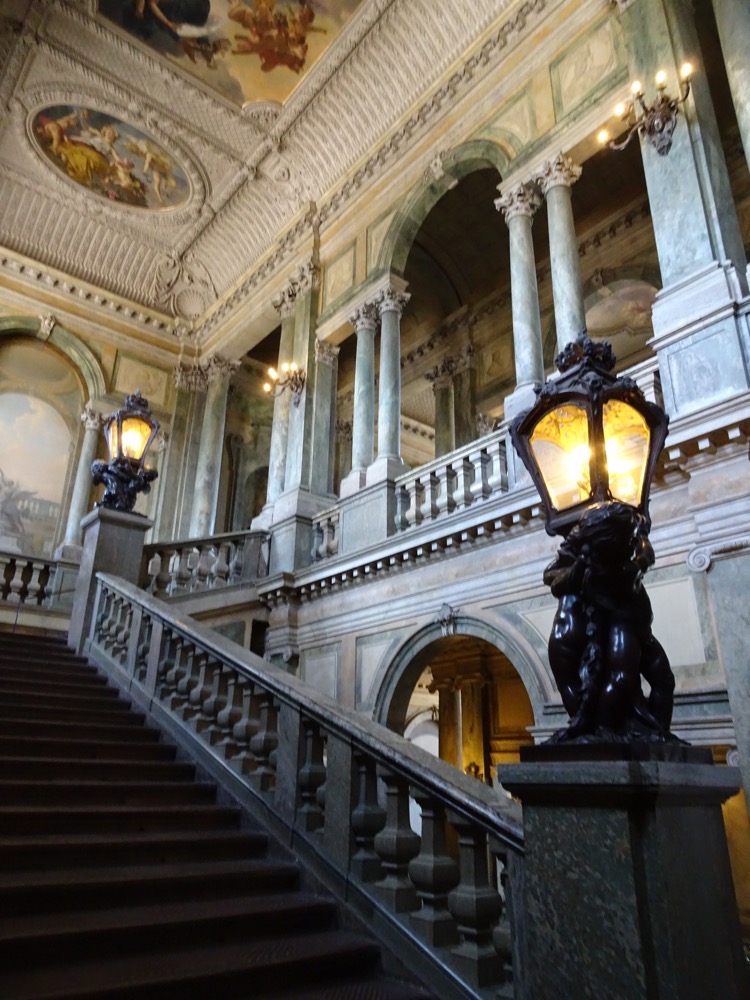
 The Royal Apartments and Guest Apartments:
The Royal Apartments and Guest Apartments: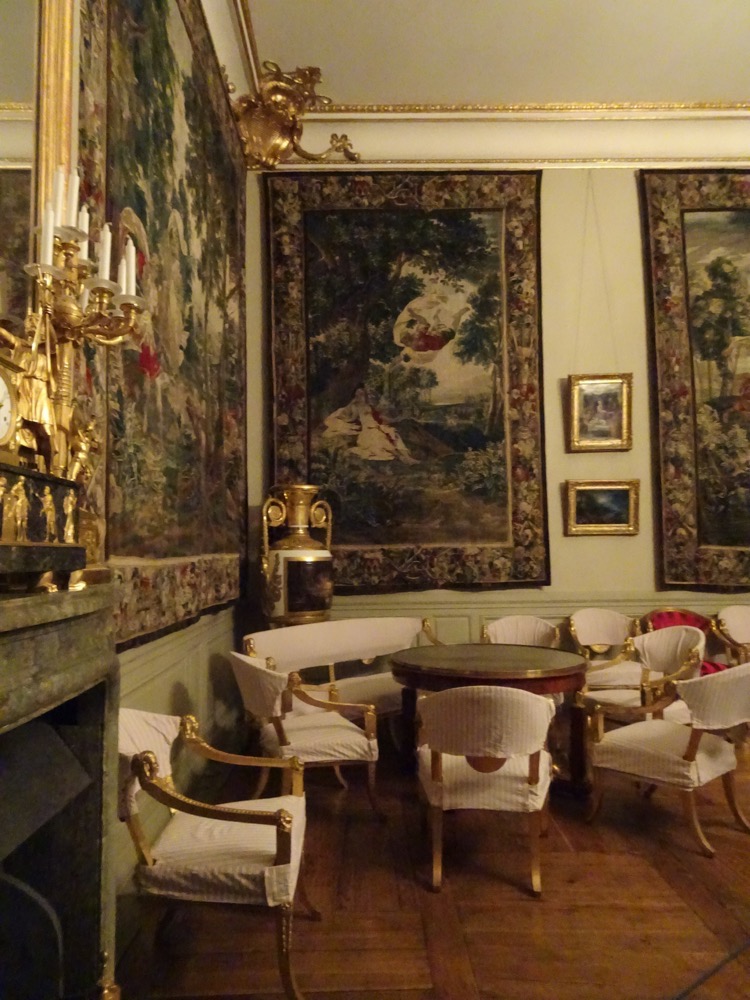
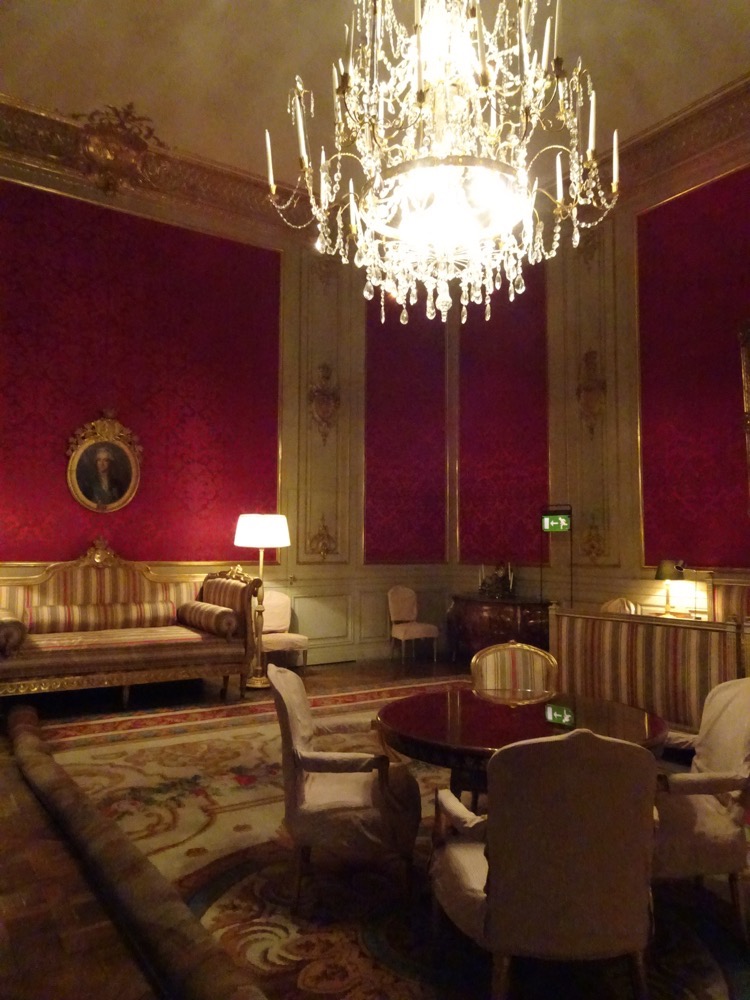



 The King’s Official Bedchamber – his actual bed chamber is behind doors somewhere, much smaller and more intimate and therefore more easily heated. The bedchambers became somewhat less formal audience chambers.
The King’s Official Bedchamber – his actual bed chamber is behind doors somewhere, much smaller and more intimate and therefore more easily heated. The bedchambers became somewhat less formal audience chambers.
 Ceiling detail:
Ceiling detail:
 Musian’s loft in a salon.
Musian’s loft in a salon.
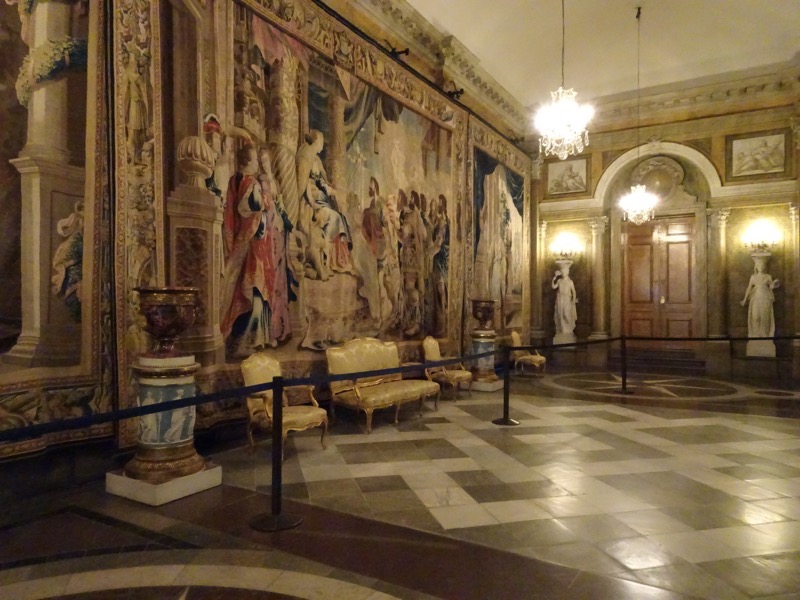
 Familiy portrait gallery.
Familiy portrait gallery. Guest apartment:
Guest apartment:


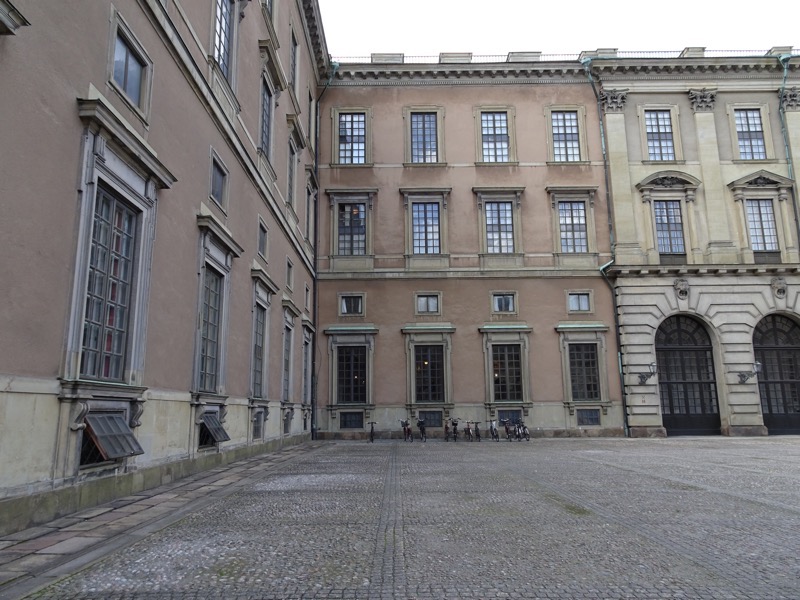 Forward circular courtyard:
Forward circular courtyard: Roya Chapel:
Roya Chapel:

 Crown of Queen Christina of Sweden. c.1620.
Crown of Queen Christina of Sweden. c.1620.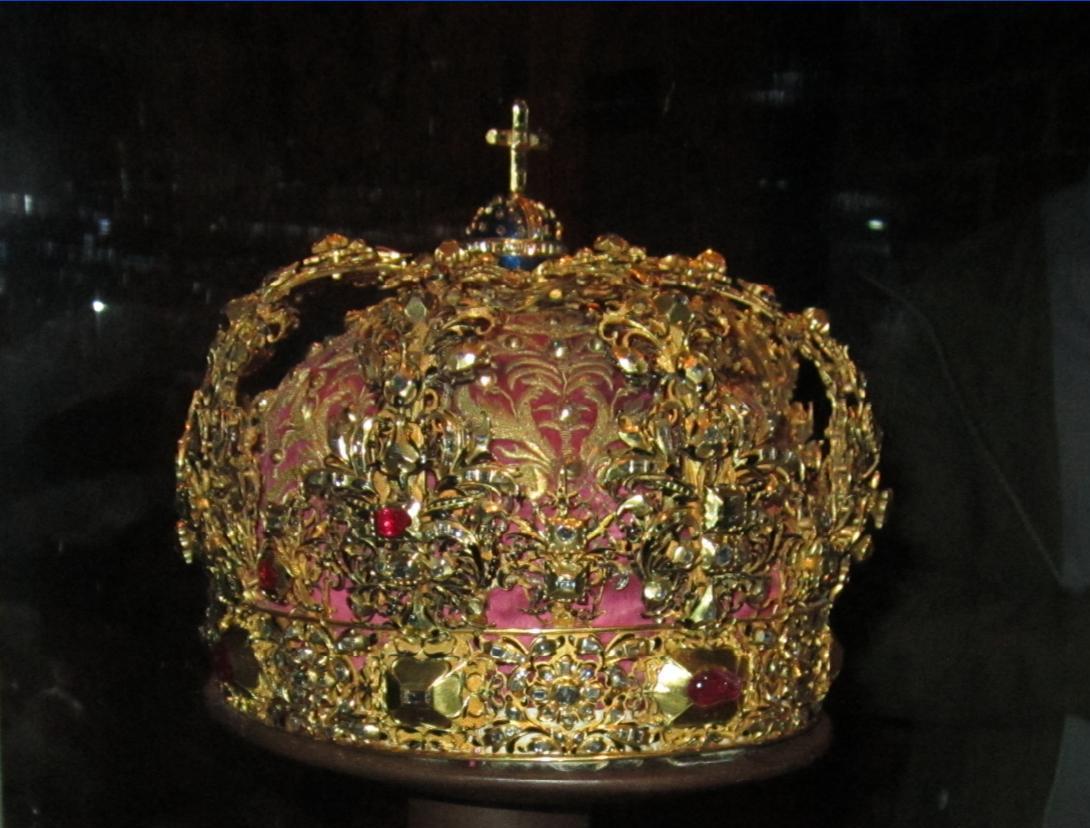 Coronet and septre of the Queen Consort. c.1751.
Coronet and septre of the Queen Consort. c.1751. Coronet of the Heir Apparent. c.1772
Coronet of the Heir Apparent. c.1772
 As I was leaving a parade was coming by – there is a cultural festival on in Stockholm this week, so the inner city is full of pavilions with international food, and stages for music performances.
As I was leaving a parade was coming by – there is a cultural festival on in Stockholm this week, so the inner city is full of pavilions with international food, and stages for music performances.

 Then I had to come back to the hotel to do some work before heading out this evening to the formal reception at the Stockholm City Hall as part of the conference schedule.
Then I had to come back to the hotel to do some work before heading out this evening to the formal reception at the Stockholm City Hall as part of the conference schedule.


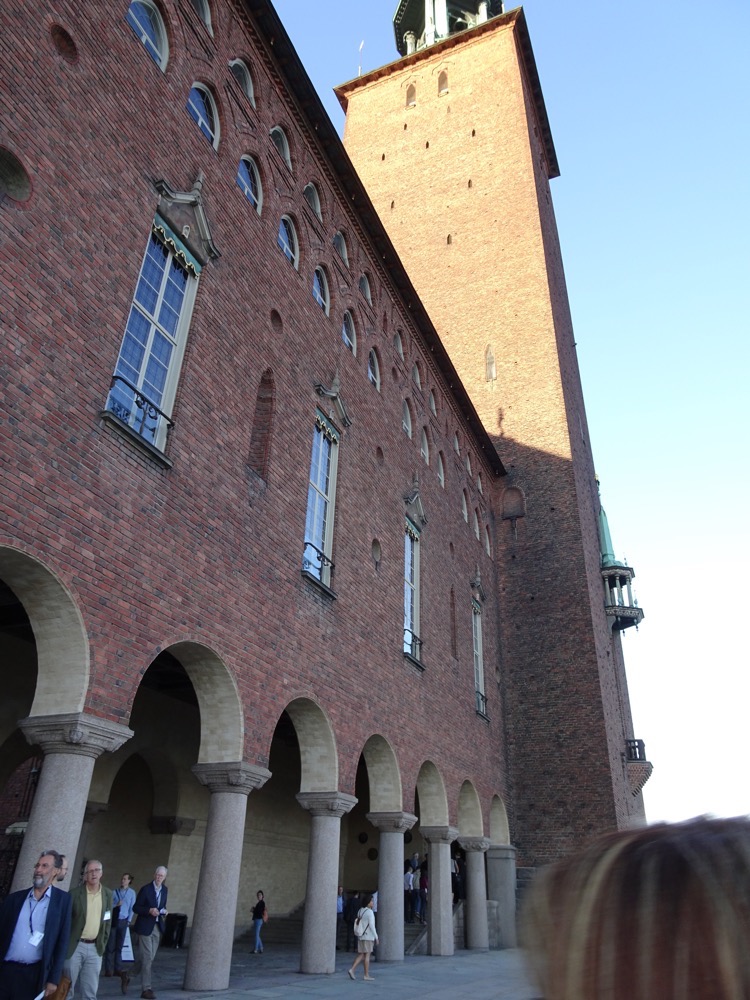 The building looks a lot older than it is – it was built only in the early 1900s, but very much looks part of the architectural heritage of Stockholm.
The building looks a lot older than it is – it was built only in the early 1900s, but very much looks part of the architectural heritage of Stockholm. The formal entrance foyer is covered in large tapestries.
The formal entrance foyer is covered in large tapestries.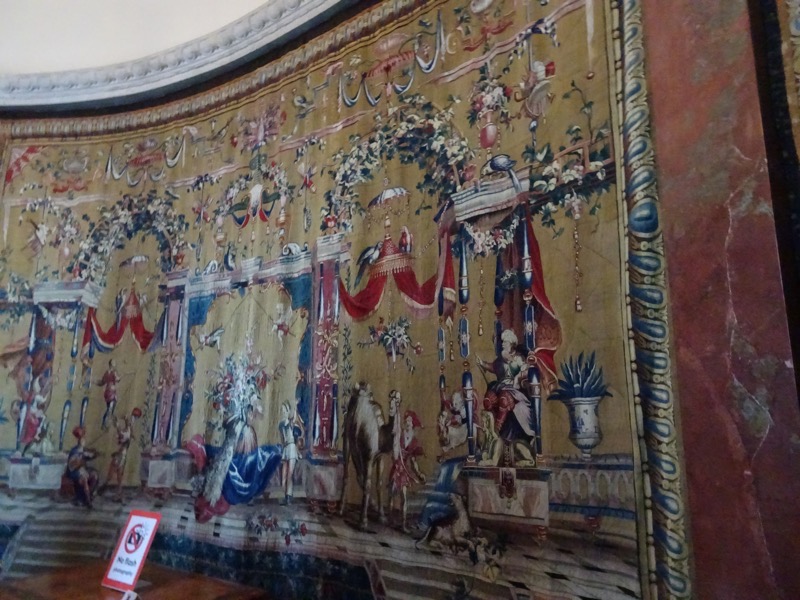

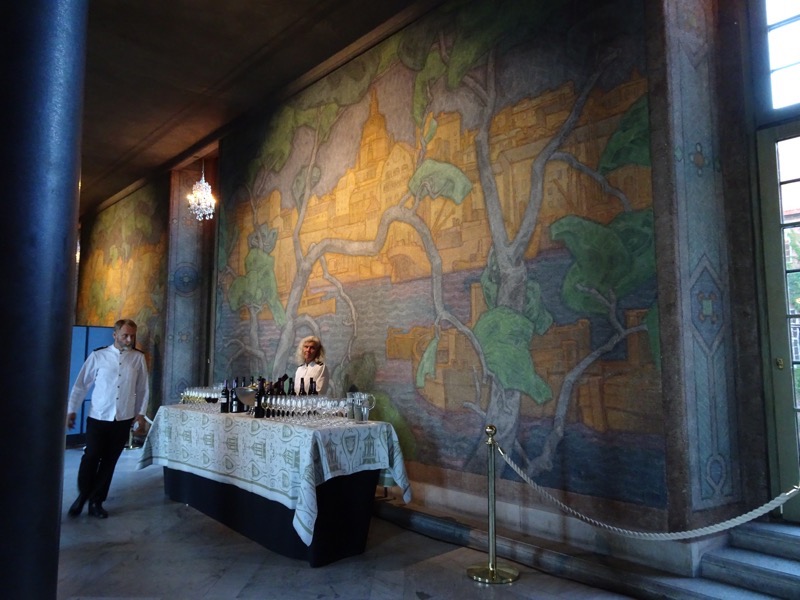 The Blue Room where we had our reception. They had laid on the most lavish meal with lots of salmon, pickled herrings, potato au gratin, cauliflower terrine, beets, cheeses, breads and the ubiquitous Swedish meatballs (Which we have been served every morning since we got here! Who knew meatballs were a breakfast food?!)
The Blue Room where we had our reception. They had laid on the most lavish meal with lots of salmon, pickled herrings, potato au gratin, cauliflower terrine, beets, cheeses, breads and the ubiquitous Swedish meatballs (Which we have been served every morning since we got here! Who knew meatballs were a breakfast food?!)

 Ceiling detail.
Ceiling detail. View out the windows of the reception room – across to Riddarholmen and Södermalm.
View out the windows of the reception room – across to Riddarholmen and Södermalm.  Right off the Blue Room lies the Golden Hall (Gyllene Salen), which is very aptly named for the beautiful golden decorative mosaics that line the entire walls of the expansive halls. There are over 18 million mosaic tiles in this room that have been used to create scenes from Swedish history. The mosaics were commissioned from a German firm called Puhl & Wagner and it took over nine years for the commision to be completed (1883-1941). I was blown away by the sheer beauty of the room and took so many photographs of the mosaic scenes.
Right off the Blue Room lies the Golden Hall (Gyllene Salen), which is very aptly named for the beautiful golden decorative mosaics that line the entire walls of the expansive halls. There are over 18 million mosaic tiles in this room that have been used to create scenes from Swedish history. The mosaics were commissioned from a German firm called Puhl & Wagner and it took over nine years for the commision to be completed (1883-1941). I was blown away by the sheer beauty of the room and took so many photographs of the mosaic scenes.
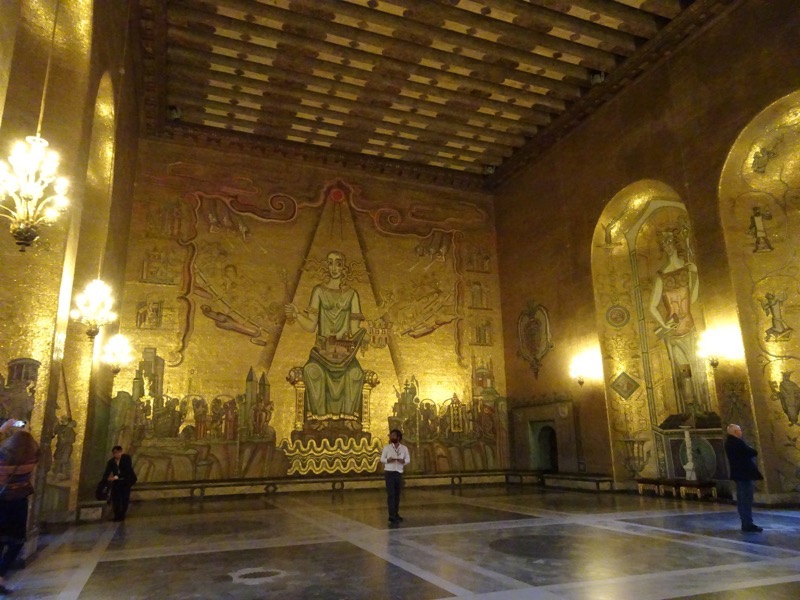

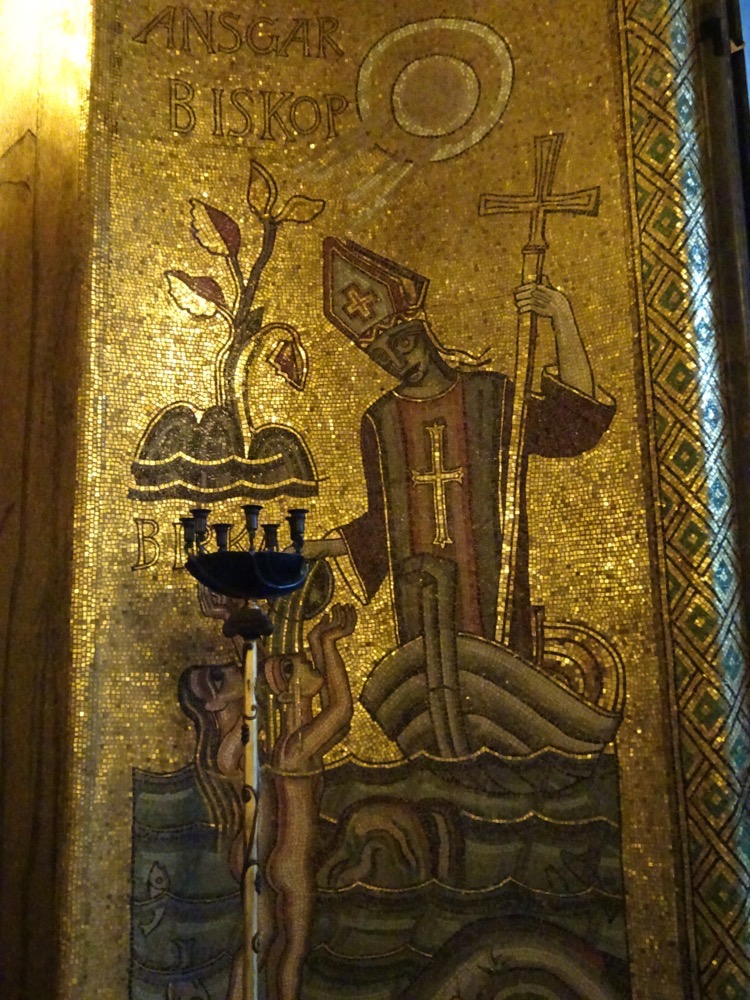
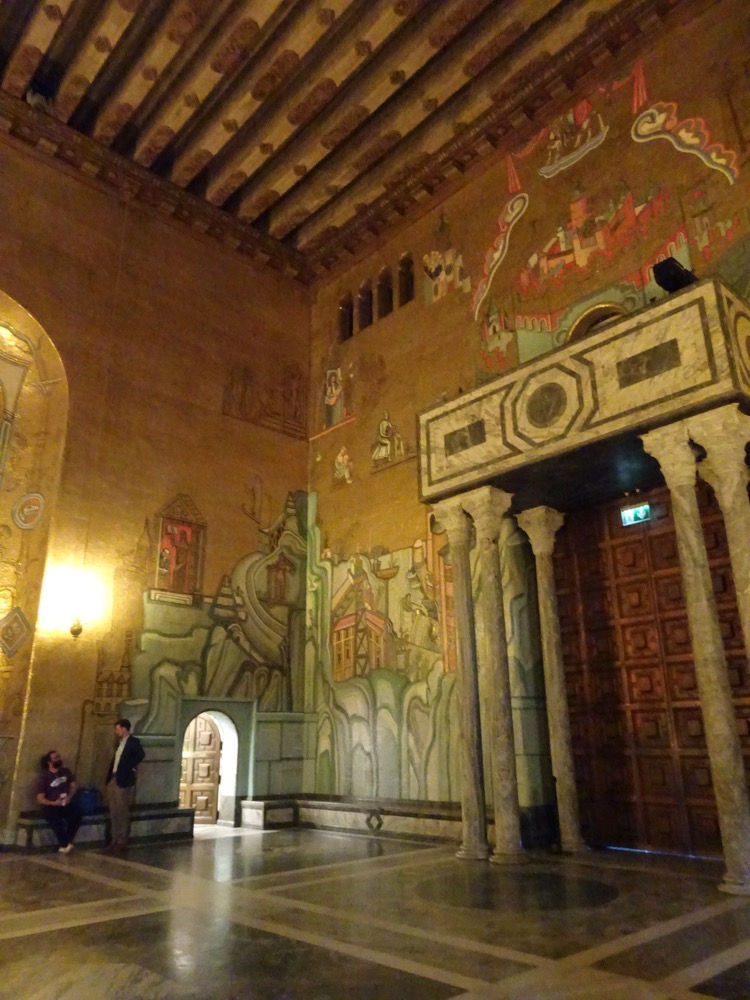






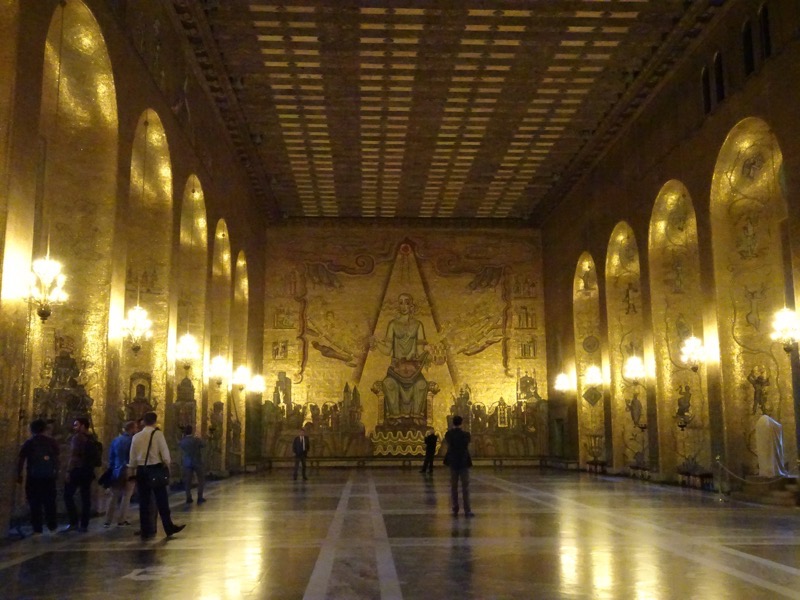
 The room is used after the Nobel Prize ceremonies for a ballroom, and it is not often that people can come here without being on an offical tour of the building… I was thrilled to be able to take so many pictures, and contemplate the grandeur of this place in a relatively small group. Seeing a masterpiece of decorative arts like this is always impressive – the workmanship, the creativity and the time, the sheer time that goes into making something like this is incredible.
The room is used after the Nobel Prize ceremonies for a ballroom, and it is not often that people can come here without being on an offical tour of the building… I was thrilled to be able to take so many pictures, and contemplate the grandeur of this place in a relatively small group. Seeing a masterpiece of decorative arts like this is always impressive – the workmanship, the creativity and the time, the sheer time that goes into making something like this is incredible.


 Direclty outside the Golden Salon is a central covered courtyard that then leads around to the Stockholm Council Chambers.
Direclty outside the Golden Salon is a central covered courtyard that then leads around to the Stockholm Council Chambers. It is an interesting contrast to move form a space covered literally in gilt tiles to a courtyard space that is rough hewn red brick.
It is an interesting contrast to move form a space covered literally in gilt tiles to a courtyard space that is rough hewn red brick.

 The Council chambers are apparently all decorated in red – as this is the ‘beating heart’ of the city of Stockholm. The designer who created this space was particularly taken with the idea of the President of the Council being under a traditional audience/throne-like valance, but the politicians at the turn of the century with no enamoured with the idea of the President sitting ‘in state’ and looking like Royalty, so they argued with the designer to remove the regal looking valanced canopy. The designer responded creatively saying that the canopy assisted with the acoustics of the room, and that it would help the President be heard. The politicians at the time, knowing nothing of acoustics, seemed to have shrugged and and acquiesed… though it has since been tested by experts who have confirmed what we would already know – that the canopy does not have offer any benefit to the acoustics at all. Well played.
The Council chambers are apparently all decorated in red – as this is the ‘beating heart’ of the city of Stockholm. The designer who created this space was particularly taken with the idea of the President of the Council being under a traditional audience/throne-like valance, but the politicians at the turn of the century with no enamoured with the idea of the President sitting ‘in state’ and looking like Royalty, so they argued with the designer to remove the regal looking valanced canopy. The designer responded creatively saying that the canopy assisted with the acoustics of the room, and that it would help the President be heard. The politicians at the time, knowing nothing of acoustics, seemed to have shrugged and and acquiesed… though it has since been tested by experts who have confirmed what we would already know – that the canopy does not have offer any benefit to the acoustics at all. Well played.
 The ceiling is painted to look like the sky so the words of the elected representatives can ‘float upwards and out into the city of Stockholm’… lovely imagery, but today the cameras in the corner that live stream proceedings to the web are probably more effective than the ceiling.
The ceiling is painted to look like the sky so the words of the elected representatives can ‘float upwards and out into the city of Stockholm’… lovely imagery, but today the cameras in the corner that live stream proceedings to the web are probably more effective than the ceiling.

 What a beautiful venue. We had a lovely evening socialising with the people we have been working with this week, and after this head back to our hotel, the Hotel Birger Jarl to have a few drinks. Lots of discussion on buses and trains and taxis ensued before being able to take off my shoes (my poor little feet!) and get some sleep.
What a beautiful venue. We had a lovely evening socialising with the people we have been working with this week, and after this head back to our hotel, the Hotel Birger Jarl to have a few drinks. Lots of discussion on buses and trains and taxis ensued before being able to take off my shoes (my poor little feet!) and get some sleep.
 The Vasa Museet! I stopped in because I simply couldn’t help myself, but I am not going to write about it yet – as part of our conference, we are having a private after-hours tour of the Vasa with the Director of the museum, followed by a formal conference dinner, which is also being held here on Wednesday night. As such, I am likely to gain more information that I will want to include – so I’m going to put it all in a later post.
The Vasa Museet! I stopped in because I simply couldn’t help myself, but I am not going to write about it yet – as part of our conference, we are having a private after-hours tour of the Vasa with the Director of the museum, followed by a formal conference dinner, which is also being held here on Wednesday night. As such, I am likely to gain more information that I will want to include – so I’m going to put it all in a later post. Here is a sneak preview couple of photos though – it is just as impressive as I had imagined, and such an amazing facility to display the warship in. Much, much more to follow in a couple of days.
Here is a sneak preview couple of photos though – it is just as impressive as I had imagined, and such an amazing facility to display the warship in. Much, much more to follow in a couple of days.
 After this, I decided to visit the Nordiska Museet. The Nordic Museum is a Swedish cultural history museum, located at Lejonslätten in the Djurgården. They say, if you want to understand the Swedes and Sweden, you must visit here. The museum attempts to preserve the daily lives and work of Sweden from the 16thC to today. Apparently, it is Sweden’s largest cultural history museum with a collection of over 1.5 million items – needless to say, I did not see them all. And to be completely honest I pretty much skimmed past most things that were post-1600 (as you do when you are predominantly interested in medieval history).
After this, I decided to visit the Nordiska Museet. The Nordic Museum is a Swedish cultural history museum, located at Lejonslätten in the Djurgården. They say, if you want to understand the Swedes and Sweden, you must visit here. The museum attempts to preserve the daily lives and work of Sweden from the 16thC to today. Apparently, it is Sweden’s largest cultural history museum with a collection of over 1.5 million items – needless to say, I did not see them all. And to be completely honest I pretty much skimmed past most things that were post-1600 (as you do when you are predominantly interested in medieval history). The museum is in a gorgeous building (c1889-1907) founded by Artur Hazelius, who also founded the Skansen Open-Air Museum, which I went to later.
The museum is in a gorgeous building (c1889-1907) founded by Artur Hazelius, who also founded the Skansen Open-Air Museum, which I went to later. The main hall is spectacular – at the moment there is an exhibition on in here, representing the Aurora Borealis… images, a collection, and a weird darkened room that you can go into, let your eyes adjust, then a visual representation of the northern lights appears overhead. It was interesting, but they have not depicted the phenomenon as vibrant, animated or as bright as it is in real life.
The main hall is spectacular – at the moment there is an exhibition on in here, representing the Aurora Borealis… images, a collection, and a weird darkened room that you can go into, let your eyes adjust, then a visual representation of the northern lights appears overhead. It was interesting, but they have not depicted the phenomenon as vibrant, animated or as bright as it is in real life. Gustav III carved in oak and made enormous.
Gustav III carved in oak and made enormous. There was a historical costume exhibition section, but everything was post-17thC, so I kinda hopped and skipped through that with a few stops to enjoy the fabrics.
There was a historical costume exhibition section, but everything was post-17thC, so I kinda hopped and skipped through that with a few stops to enjoy the fabrics.



 Then there is an extensive jewellery collection – but again, all items were 17th-18thC, so I didn’t record any particular detail of them, just enjoyed the pretties and took a few photos of the more stunning piece.
Then there is an extensive jewellery collection – but again, all items were 17th-18thC, so I didn’t record any particular detail of them, just enjoyed the pretties and took a few photos of the more stunning piece.



 Bit obscure – but these are 18thC brooches.
Bit obscure – but these are 18thC brooches.
 And then a toy and dollhouses exhibit… which was pretty cool. I have seen large royal doll houses in the UK, and in Austria. I’ve never really understood the fascination with them. I was always more of a train sets and footballs kinda kid.
And then a toy and dollhouses exhibit… which was pretty cool. I have seen large royal doll houses in the UK, and in Austria. I’ve never really understood the fascination with them. I was always more of a train sets and footballs kinda kid.

 And then I got to the tableware… All photos included here are pre 17thC. Serving dishes, drinking horns, ewers, knives, spoons and all good things. I have a bit more information on some of the items came from – but they are all made in Sweden and all date from the 1500s.
And then I got to the tableware… All photos included here are pre 17thC. Serving dishes, drinking horns, ewers, knives, spoons and all good things. I have a bit more information on some of the items came from – but they are all made in Sweden and all date from the 1500s.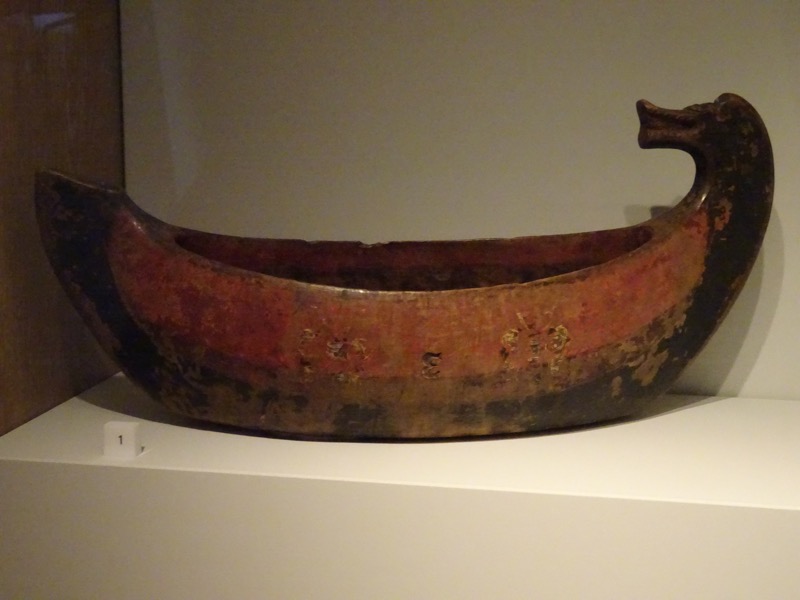
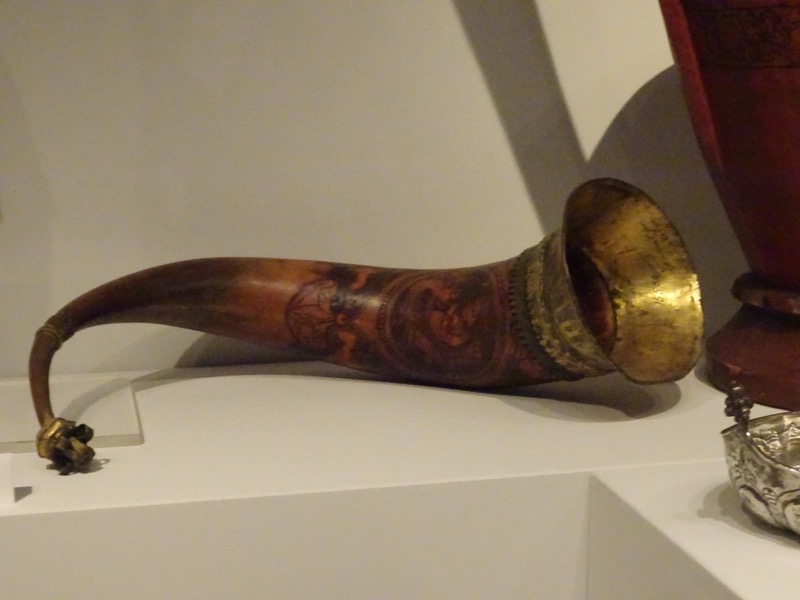
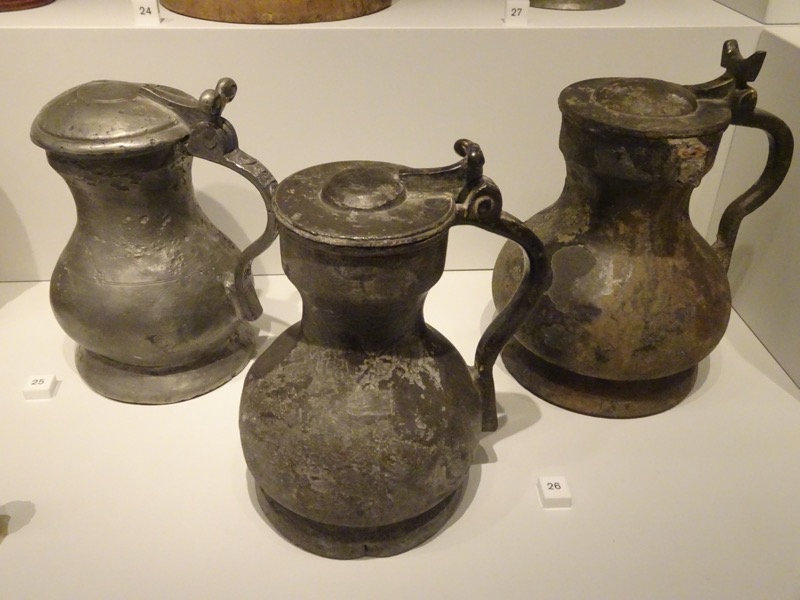

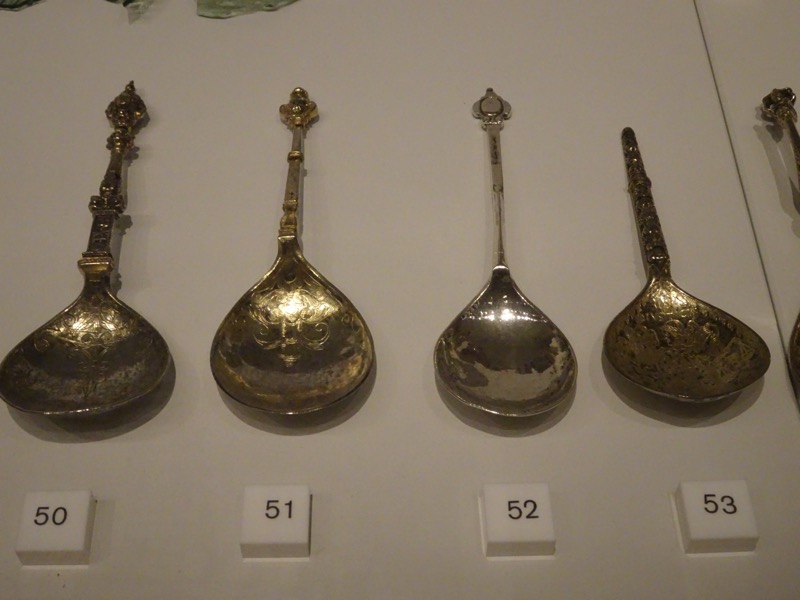

 Owen, if you are reading this – this travel KFS set should be on your ‘to-do’ list… it’s c.1560 and has a carved wooden case to store them in.
Owen, if you are reading this – this travel KFS set should be on your ‘to-do’ list… it’s c.1560 and has a carved wooden case to store them in.
 Carving set c.1589
Carving set c.1589
 I also saw some photographic exhibitions, a series of dioramas depicting Nordic traditions (covering everything from weddings to Christmases to funerals), an exhibition on Swedish furniture and lighting design and the ever present museum gift shop. I have discovered that I’m not that fond of modern Swedish design… well, actually that is not entirely true. I have never been a fan of Ikea design either – and the museum worthy designer objects exhibition seemed to be the precursor to a modern Ikea catalogue. So I should not have been surprised to find it a little lacking in the lustre department for me. It’s just not my cup of tea.
I also saw some photographic exhibitions, a series of dioramas depicting Nordic traditions (covering everything from weddings to Christmases to funerals), an exhibition on Swedish furniture and lighting design and the ever present museum gift shop. I have discovered that I’m not that fond of modern Swedish design… well, actually that is not entirely true. I have never been a fan of Ikea design either – and the museum worthy designer objects exhibition seemed to be the precursor to a modern Ikea catalogue. So I should not have been surprised to find it a little lacking in the lustre department for me. It’s just not my cup of tea. Oh, I was so wrong! This place was 1) expensive to get into but thankfully I got a discount with the Stockholm Pass, 2) set up for people who know absolutely nothing about iron age history and have to be spoon fed, and 3) finished with an alarming Disneyesque ‘ride’ through models and vignettes depicting a character named Ragnifrid sending her husband, Harald, on a two year journey to find barrels of silver – complete with fake lightning, a too loud and over enthusiastic commentary track, dodgy visual effects and a jerky carriage/train thing taking you through rooms in the dark. It was Madame Tussauds all over again!
Oh, I was so wrong! This place was 1) expensive to get into but thankfully I got a discount with the Stockholm Pass, 2) set up for people who know absolutely nothing about iron age history and have to be spoon fed, and 3) finished with an alarming Disneyesque ‘ride’ through models and vignettes depicting a character named Ragnifrid sending her husband, Harald, on a two year journey to find barrels of silver – complete with fake lightning, a too loud and over enthusiastic commentary track, dodgy visual effects and a jerky carriage/train thing taking you through rooms in the dark. It was Madame Tussauds all over again! A partial life size replica of a viking longboat. Below, a model of a viking long house…
A partial life size replica of a viking longboat. Below, a model of a viking long house…
 A recreated viking meal: Boiled pork with thyme and lovage, black pudding with pieces of pork and apple, honey-glazed ham, freshly baked crispbread with butter. Smoked cheese with cummin, goat’s milk feta, bowls of nuts and apples on a skewer, and mead.
A recreated viking meal: Boiled pork with thyme and lovage, black pudding with pieces of pork and apple, honey-glazed ham, freshly baked crispbread with butter. Smoked cheese with cummin, goat’s milk feta, bowls of nuts and apples on a skewer, and mead. Key, iron bronze and copper, bolt key & Key iron, Functional claw key.
Key, iron bronze and copper, bolt key & Key iron, Functional claw key. Counters and dice, antler and bone.
Counters and dice, antler and bone. Spindle whorl, burnt clay, Solberga, Koping Parish, Oland
Spindle whorl, burnt clay, Solberga, Koping Parish, Oland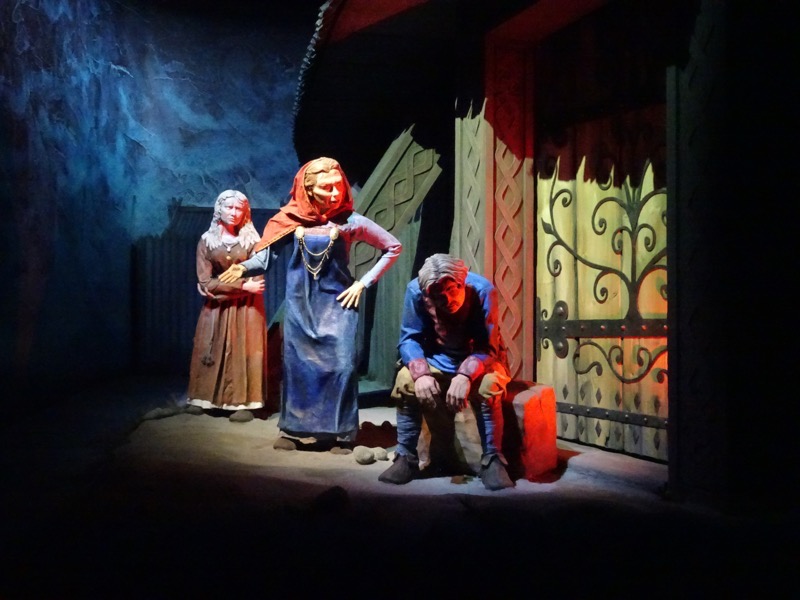




 Thunderbolts and lightning, very very frightening.
Thunderbolts and lightning, very very frightening.
 Hiroshi Yamada – “Absolute Yamada”, Oil on wood
Hiroshi Yamada – “Absolute Yamada”, Oil on wood
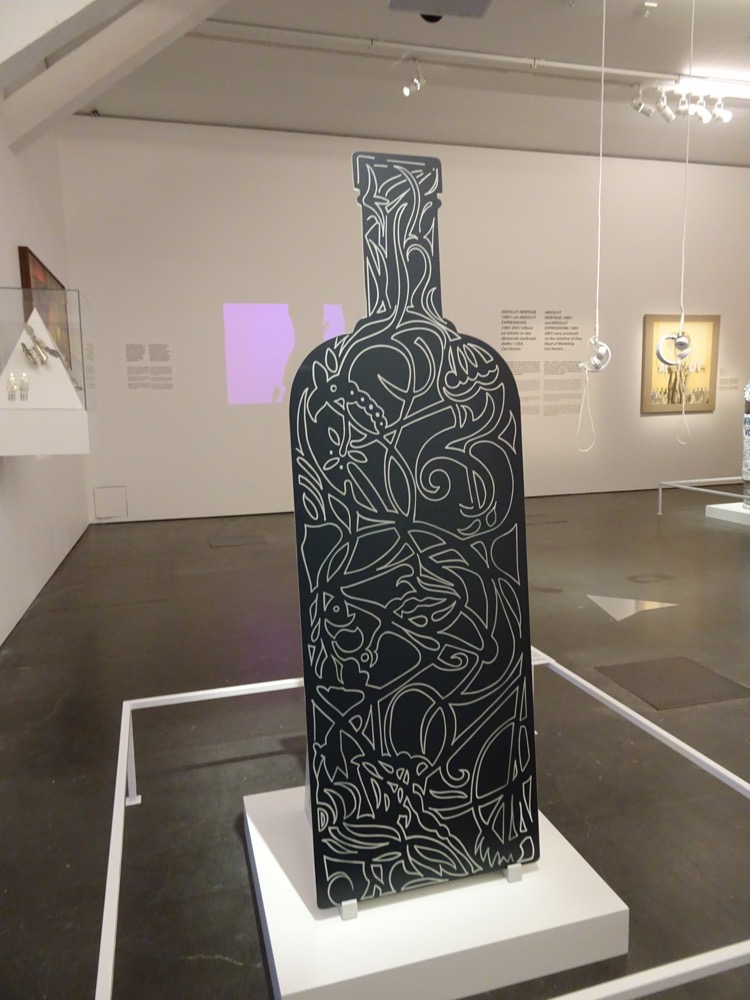
 Gregory Warmack – Mr Imagination, sculpture with bottlecaps and tinfoil.
Gregory Warmack – Mr Imagination, sculpture with bottlecaps and tinfoil.
 Absolut Bailey – Xenobia Bailey, mixed media hand crochetd, poly yarn and plastic beads.
Absolut Bailey – Xenobia Bailey, mixed media hand crochetd, poly yarn and plastic beads. Rostislav Lebedev – Absolut Lebedev, Acrylic on paper.
Rostislav Lebedev – Absolut Lebedev, Acrylic on paper. Alexander Kosolapov – Absolut Kosolapov, acrylic on canvas.
Alexander Kosolapov – Absolut Kosolapov, acrylic on canvas. Irina Nakhova – Absolut Nakhova, arcrylic on canvas.
Irina Nakhova – Absolut Nakhova, arcrylic on canvas.

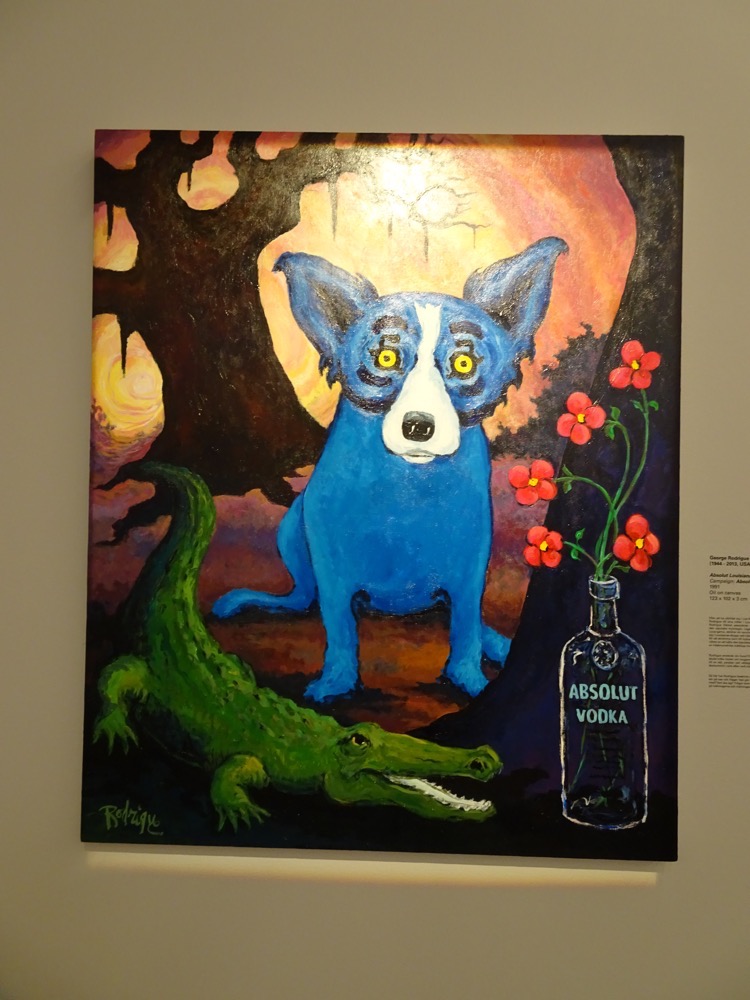









 There are over 150 buildings from all over Sweden that have been dismantled and reassembled in the area. There is also a Zoo containing bears, wolves, and lynx and a kid’s petting zoo as well. The most interesting area (to me) was the town quarter which has a bakery, a furniture workshop, a pottery workshop, a glass blowing facility, pubs and restaurants and many other places of general industry.
There are over 150 buildings from all over Sweden that have been dismantled and reassembled in the area. There is also a Zoo containing bears, wolves, and lynx and a kid’s petting zoo as well. The most interesting area (to me) was the town quarter which has a bakery, a furniture workshop, a pottery workshop, a glass blowing facility, pubs and restaurants and many other places of general industry.
 The bakers selling delicious period buns – vanilla bun also tasted strangely of cardamom. Interesting but it worked.
The bakers selling delicious period buns – vanilla bun also tasted strangely of cardamom. Interesting but it worked.
 Glass blowing working and moulds for glasswork.
Glass blowing working and moulds for glasswork. All of which is on sale of course, though I am unsure how ‘period’ little pink elephants are…
All of which is on sale of course, though I am unsure how ‘period’ little pink elephants are…
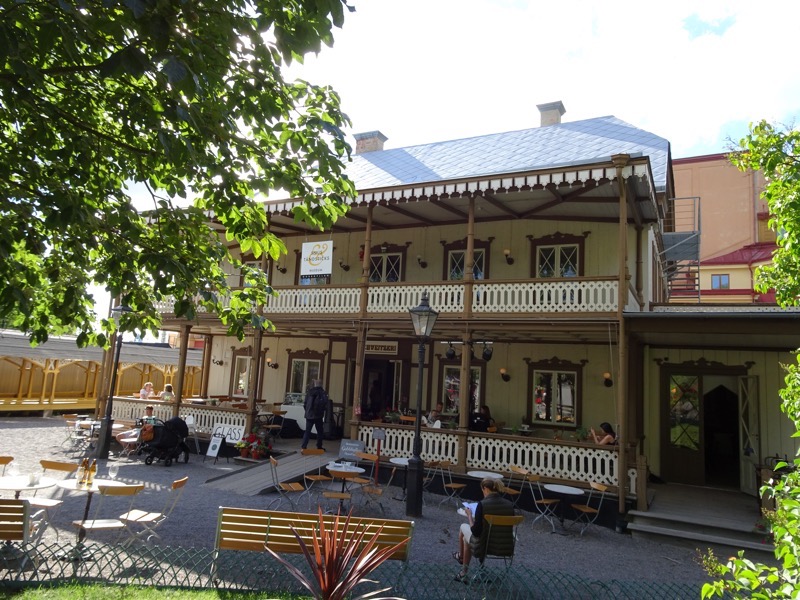

 Skansen tower
Skansen tower Some traditional grass and thatched roofed farming cottages.
Some traditional grass and thatched roofed farming cottages.
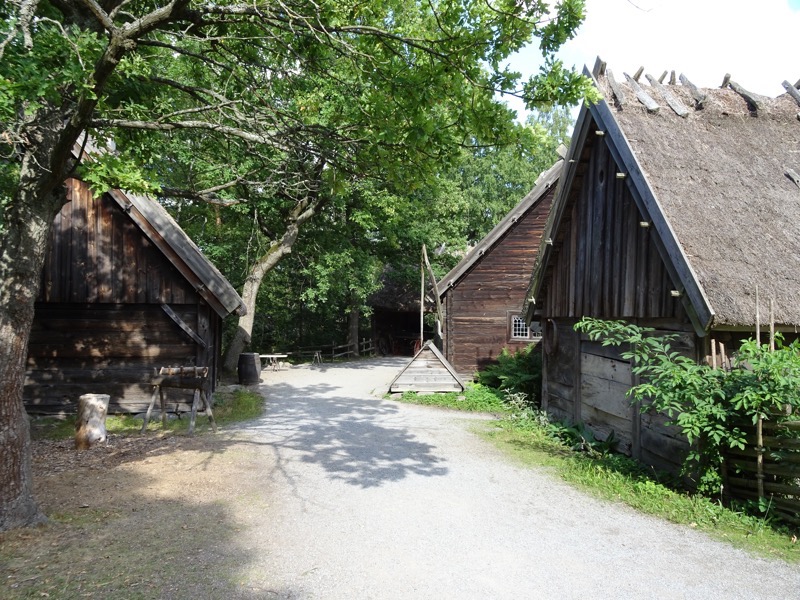
 This is the Seglora church from the Seglora Parish and built in 1730 official church, opened in 1730. The church is still an active ecumenical church with regular worship services and it is one of Sweden’s most popular wedding churches apparently. Not hard to see why, it is very picturesque.
This is the Seglora church from the Seglora Parish and built in 1730 official church, opened in 1730. The church is still an active ecumenical church with regular worship services and it is one of Sweden’s most popular wedding churches apparently. Not hard to see why, it is very picturesque.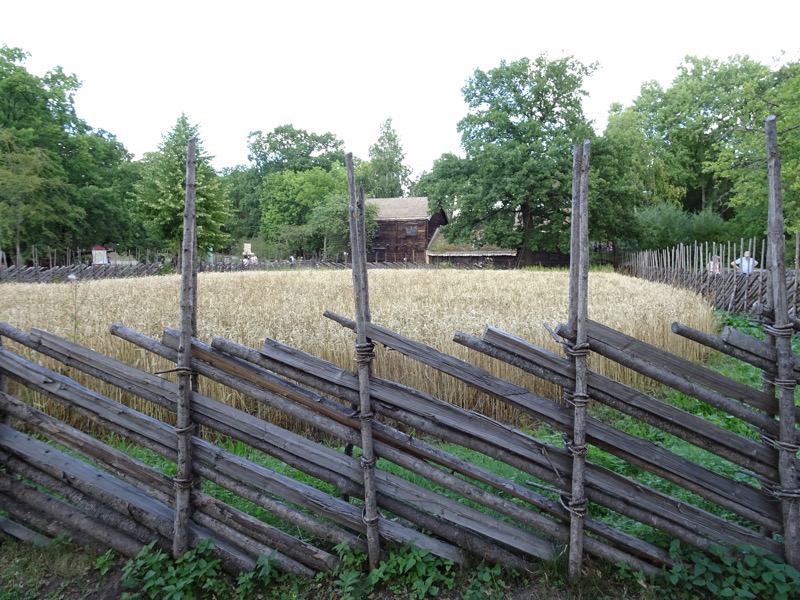
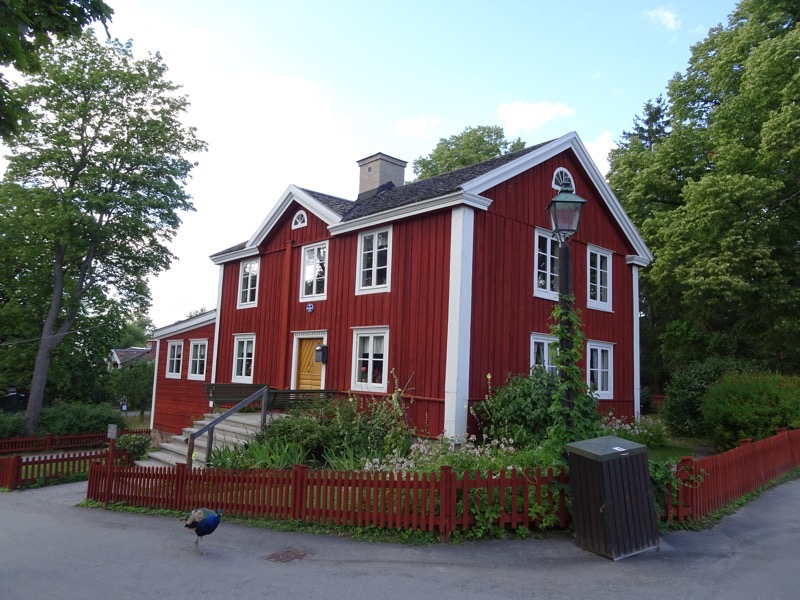 Ekshäradsgården is a farmhouse dating from the 1820s, which was in Norra Skoga, Ekshärads, and was moved to Skansen 1952-1953,
Ekshäradsgården is a farmhouse dating from the 1820s, which was in Norra Skoga, Ekshärads, and was moved to Skansen 1952-1953, An Allotment House – tiny house with large self-sustaining kitchen gardens. There are rows of them in the village.
An Allotment House – tiny house with large self-sustaining kitchen gardens. There are rows of them in the village.
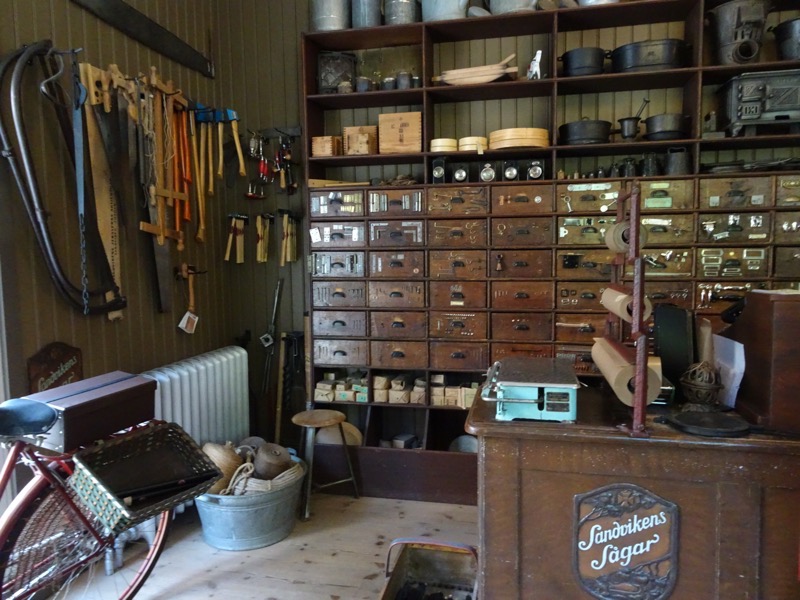



 The holding area is the dark grey parallelogram shape at the top (left one for us) of this diagram next to the little customs dude icon. The unlinked circular squiggles are a baggage claim area that is roughly the size of a usual baggage claim area… meaning the holding area was stupidly fucking tiny for 700+ people to wait, cheek to jowl, for over an hour. No wonder people were getting restless and in each other’s faces. And what a bloody fire hazard!
The holding area is the dark grey parallelogram shape at the top (left one for us) of this diagram next to the little customs dude icon. The unlinked circular squiggles are a baggage claim area that is roughly the size of a usual baggage claim area… meaning the holding area was stupidly fucking tiny for 700+ people to wait, cheek to jowl, for over an hour. No wonder people were getting restless and in each other’s faces. And what a bloody fire hazard! Our taxi driver dropped us off at Terminal D, as was indicated on our pre-checked in boarding passes that we printed out at the hotel, which is the grey funnel shaped area at the bottom of this picture. When we went through the process of handing over our passports and dropping off our luggage, it was just in that first grey area where there was approximately 50 or more numbered check in counters. Vitaly, who checked us in, told us our gate had changed from Gate 5 to Gate 44 and he directed us to go to Terminal F to find our gate. So, we walked all the way around to Terminal F (about 1.4kms) on the outside immigration and clearance, ‘grey area’, on the map, landing us at the red ‘i’ site on the concourse (it’s depicted just above the green text boxes in the map above). When we got there, there were check-in counters all numbered 100-150, but no signs directing patrons to Gate 44 at all. Each terminal has multiple security clearance entrance points, but we had no idea where we were going so we asked the lady as the ‘i’ site to check if we were in the right area.
Our taxi driver dropped us off at Terminal D, as was indicated on our pre-checked in boarding passes that we printed out at the hotel, which is the grey funnel shaped area at the bottom of this picture. When we went through the process of handing over our passports and dropping off our luggage, it was just in that first grey area where there was approximately 50 or more numbered check in counters. Vitaly, who checked us in, told us our gate had changed from Gate 5 to Gate 44 and he directed us to go to Terminal F to find our gate. So, we walked all the way around to Terminal F (about 1.4kms) on the outside immigration and clearance, ‘grey area’, on the map, landing us at the red ‘i’ site on the concourse (it’s depicted just above the green text boxes in the map above). When we got there, there were check-in counters all numbered 100-150, but no signs directing patrons to Gate 44 at all. Each terminal has multiple security clearance entrance points, but we had no idea where we were going so we asked the lady as the ‘i’ site to check if we were in the right area. See this map? And the icons for ‘Shop’ and ‘Dury-Free Shop’… note also how there are not present on the map? That is because the entire map would have measles if they were included.
See this map? And the icons for ‘Shop’ and ‘Dury-Free Shop’… note also how there are not present on the map? That is because the entire map would have measles if they were included.